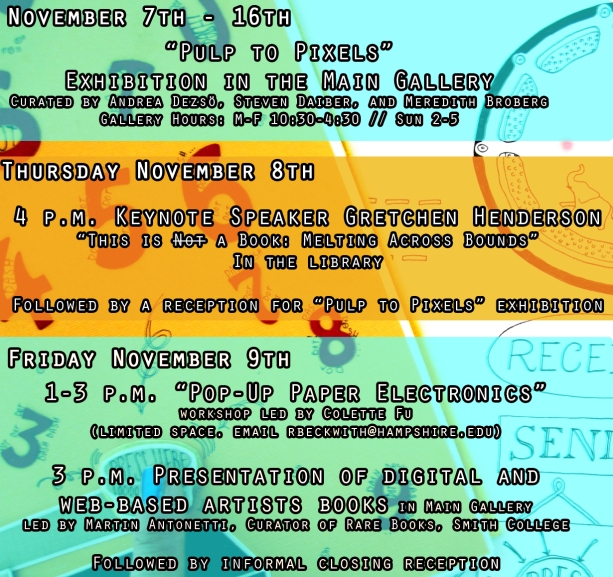
Digitalne "knjige" nisu više samo sredstvo prenošenja starih oblika knjige, nego i prostor za potpuno nove mogućnosti. One sve češće uopće više nisu namijenjene tiskanju. Tweet ima svoju poeziju (Patricia Lockvood, više ovdje), Petra Cortright u e-knjigu je prenijela "sadržaj" svog desktopa (više ovdje). Izložba Non-Visible and Intangible predstavila je autore koji otkrivaju kako tehnologija utječe na sve aspekte stvaranja suvremenih "knjiga" i njihovih novih značenja.
Nick Montfort ima jedan od najvažnijih blogova o interaktivnom pripovijedanju, kreativnom digitalnom pisanju, video i kompjutorskim igrama i sl.
Badlands Unlimited je važan izdavač e-knjiga koje pomiču granice (Sve je reality show, jedini spas su reklame!).
Non-Visible and Intangible
The events explore how technology has affected all aspects of artists books – from production to creation to access and use. Some of the works on display explore interactive generative art with text and image, some function as books in their own right but can be enhanced with technology, and others require a smartphone or tablet to view them at all.
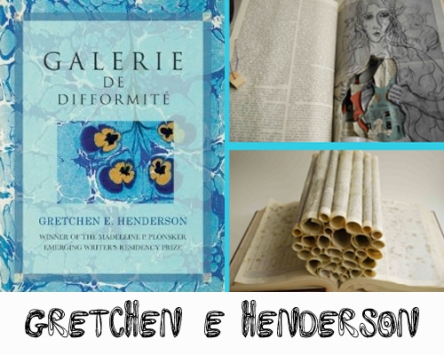
Galerie de Difformite Keynote Speaker Gretchen E Henderson describes this book and collaborative project: “Lushly designed with crowdsourced images, text deconstructions, and narrative tomfoolery, the Galerie is both funhouse and curiosity cabinet, art catalogue and ‘choose your own adventure.’ This bestiary of the novel-as-poem-as-essay-as-art grows outside of the bounds of the Book and, in the process, redefines deformity for the digital millennium.” Collaborative participation is invited at: http://difformite.wordpress.com[o G. Henderson više ovdje]
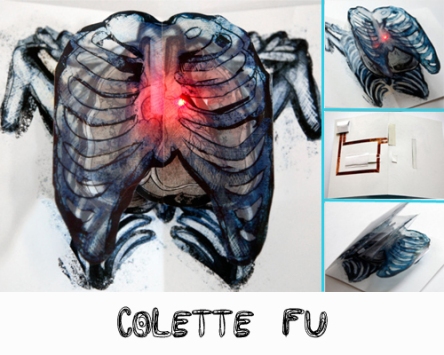
Colette Fu will be creating a piece of art specifically for this exhibition. She describes her work: “I make one-of-a-kind collapsible artist’s books that combine my photography with pop-up paper engineering. With pop-up books I want to eliminate the boundaries between book, installation, photography, craft and sculpture.” http://colettefu.com














Open-Book is an accordion-fold book of eleven five-line observations on an ancient form of interior décor known as marble revetment. The texts float on marble simulations made using the drawing and filtering functions of photo-manipulation software.http://www.uglyducklingpresse.org/catalog/browse/item/?pubID=108
M. Kasper has been publishing in literary and art magazines and with small presses for forty years. In an entry on him in The Dictionary of the Avant-Gardes (1993; 2000), Richard Kostelanetz wrote, "His colleagues commonly rank his tart visual/verbal fictions among the best," and Christopher Middleton says "A Kasper a day keeps the moodles away." Kasper's previous books, all of which mix words and pictures, include Border Crossing (1973), Chinese-English Sentence Cards (1979), Billy! Turn Down that TV! (1983), Verbo-Visuals (1985), Plans for the Night (1987), All Cotton Briefs (1985; 1992), Iconoclasm in Pontus (1999), The Shapes and Spacing of the Letters (1995; 2004), and Open-Book (UDP 2010). He has also done a few translations: Saint Ghetto of the Loans, by Gabriel Pomerand (with Bhamati Viswanathan, UDP 2006), The Development of Aerial Militarism, and The Demobilization of European Ground Forces, Fortresses and Naval Fleets, by Paul Scheerbart (UDP 2007), Correspondance: The Birth of Belgian Surrealism (with Jan Baetens, forthcoming). M. Kasper was born in the Bronx (1947), lived overseas for some years, and for the last many has been in Western Massachusetts, working as a librarian.

Table For Two combines the page and panel framework of comics, with sound and motion from time-based media, and choice-driven user participation from interactive media. To further reinforce the concept of blending old and new media, it is presented in an old-fashioned penny arcade-style viewing machine.
http://a.parsons.edu/~garnc413/thesis/prototype1_2/page2b.html

HELL_TREE is the first e-book by acclaimed net artist Petra Cortright. HELL_TREE consists of a series of writings by Cortright that exists solely within the context of her computer desktop. To-do lists conflate with poems. Motivational pronouncements interlace with inflammatory tweets.
https://itunes.apple.com/us/book/hell-tree/id526422683?mt=11
[više ovdje]
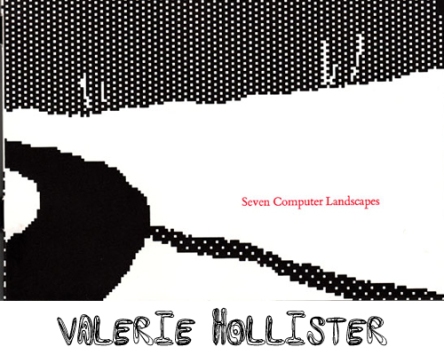
Seven Computer Landscapes The computer drawings in this book are based on pencil sketches and paintings done of actual landscape views. Seven of these drawings, along with an essay and descriptive captions, were published by Occasional Works, a small Californian press, in this accordion-fold, limited edition book in 1993.
http://www.vam.ac.uk/users/node/15070Artist Valerie Hollister has been drawing simplified landscapes on her Macintosh computer for many years. She draws 'freehand' with a mouse using a relatively simple programme. The computer drawings are based on pencil sketches and paintings done of actual landscape views. Seven of these drawings, along with an essay and descriptive captions, were published by Occasional Works, a small Californian press, in this accordion-fold, limited edition book in 1993. The seven landscapes in this perspex bound book are all of places 'away from home' for Hollister, among them: Vermont in the United States, Prevessin in France, St. Anton in Austria, and Kuala Lumpur in Malaysia. The work blends the computer drawn landscapes with the traditional letterpress printing of the text elements. For Hollister, the simplicity of her tools and their effects are significant, 'I was interested in the challenges posed by the narrow choice of grays (really combinations of black and white squares) and by the small size and scale of the black and white image seen on the screen'. Each of the original landscapes has been 'translated' using the computer to produce a new interpretation of its beauty

Sum05 is an interactive generative art app available for the iPad. The software and the user collaborate in the creation of the artistic experience. https://itunes.apple.com/us/app/sum05/id544376100?mt=8






Shake
the device to get a random color selection. Tap to reposition the
elements randomly: tap on the left side to get more, tap on the right
side to get fewer elements; how high you tap changes the way the lines
curve. Double-tap to restart all elements on the bottom of the screen.
Triple-tap for a neutral white color. Tilt the device to change the
movement of the elements on screen.
Invisible,
randomly placed obstacles are created by the machine; together with you
they play to create images that are constantly new, instantly becoming
history, never to reappear the same again.
The
software and the user collaborate in the creation of the artistic
experience, which requires no previous expertise or training from the
user's side.
Shake
the device to get a random color selection. Tap to reposition the
elements randomly: tap on the left side to get more, tap on the right
side to get fewer elements; how high you tap changes the way the lines
curve. Double-tap to restart all elements on the bottom of the screen.
Triple-tap for a neutral white color. Tilt the device to change the
movement of the elements on screen.
Invisible,
randomly placed obstacles are created by the machine; together with you
they play to create images that are constantly new, instantly becoming
history, never to reappear the same again.

The
software and the user collaborate in the creation of the artistic
experience, which requires no previous expertise or training from the
user's side.
Shake
the device to get a random color selection. Tap to reposition the
elements randomly: tap on the left side to get more, tap on the right
side to get fewer elements; how high you tap changes the way the lines
curve. Double-tap to restart all elements on the bottom of the screen.
Triple-tap for a neutral white color. Tilt the device to change the
movement of the elements on screen.
Invisible,
randomly placed obstacles are created by the machine; together with you
they play to create images that are constantly new, instantly becoming
history, never to reappear the same again.

Shake the device to
get a random color selection. Tap to reposition the elements randomly:
tap on the left side to get more, tap on the right side to get fewer
elements; how high you tap changes the way the lines curve. Double-tap
to restart all elements on the bottom of the screen. Triple-tap for a
neutral white color. Tilt the device to change the movement of the
elements on screen.
Invisible,
randomly placed obstacles are created by the machine; together with you
they play to create images that are constantly new, instantly becoming
history, never to reappear the same again.



Wht Is A Book? This series of handmade books and e-books uses a special technique of overprinting images and texts onto existing sheets of book paper. Each handmade book exists as an edition of one with two artist proofs, and as an e-book with a unique ISBN available on Apple iBooks. https://itunes.apple.com/us/book/wht-is-a-book/id485491755?mt=11What is reading? How does reading turn into knowing? How does knowing become doing? Does it matter if knowing only knows? What is a book? Is reading a book different from reading a menu, or an affidavit, or a painting? Why are books associated with bodies? When books are burned, why is it natural to assume that people are next? Does it have to do with Eros? How do you burn an e-book?
Wht is ?
This series of handmade books and e-books made by Paul Chan uses a special technique of overprinting images and texts onto existing sheets of book paper to create works that read like nothing else. The series premiered at the 2011 NY Art Book Fair. Each handmade book exists as an edition of one with two artist proofs, and as an e-book with a unique ISBN available on Apple iBooks.
Customer Reviews
Wht is a Book? exaggerates the pain of legibility. The misspelling
of standard words like ‘bok’ for ‘book’ or ‘struch’ for ‘struck’ and
‘god’ for ‘good’ point to a skimming, aggressive and pun filled process
of decoding. It is a top down approach to being read, and assumably the
right odor in which to read.
The book is comprised of quotes, seemingly taken from Chan’s notebook. Each is marked by a page number in some fashion of numerical value, sometimes repeating and other times skipping, but always getting bigger.
Focusing on the history of print media Chan details labor, process, market and an industry designed to assist the author in capital concern. We, the reader (scroller), get a taste of Chan’s angst as it is distinct in the last note and Line Item that details the underscoring of intellectual property, which forced authors to engage in a ‘production of process’.
The quotations exist on top of maps, newspapers, propaganda and images of artworks, serving as both backdrops and products of the system that bored to death the very same communities the authors desired and imagined.
Wht Is a Book?, like legibility, is a trap. It imagines the same pain and problems of decoding in a half dead culture. Chan makes it plain that reading while sleepwalking is now a thing of our collaborative present.
The book is comprised of quotes, seemingly taken from Chan’s notebook. Each is marked by a page number in some fashion of numerical value, sometimes repeating and other times skipping, but always getting bigger.
Focusing on the history of print media Chan details labor, process, market and an industry designed to assist the author in capital concern. We, the reader (scroller), get a taste of Chan’s angst as it is distinct in the last note and Line Item that details the underscoring of intellectual property, which forced authors to engage in a ‘production of process’.
The quotations exist on top of maps, newspapers, propaganda and images of artworks, serving as both backdrops and products of the system that bored to death the very same communities the authors desired and imagined.
Wht Is a Book?, like legibility, is a trap. It imagines the same pain and problems of decoding in a half dead culture. Chan makes it plain that reading while sleepwalking is now a thing of our collaborative present.

The Roar of Destiny Best described as a “complex hyperpoem,” this is an online piece begun in December 1995 and created publicly over the course of four years. New screens were slowly added and, with every addition, the links on other screens were changed, so that returning readers would have to find new paths through the poem. http://www.well.com/user/jmalloy/control.html
 .......................
....................... ...........................
........................... ......................
...................... ......................
......................
 ................................
................................

 ....................
.................... ...silently charge their batteries.
...silently charge their batteries.
 ..............
..............
 .................
.................
 ...............................
background noise............
low flying planes.............
intermittent pain...............
the smell of green grass....
warm sun.........................
a red front door................
cold cereal........................
working............................
making things....................
a white shirt.......................
making love......................
the children laughing..........
blue jeans.........................
potato soup......................
never know why...............
nausea..............................
footprints..........................
unwashed windows...........
a dark corner....................
the pine trees overhead......
walking.............................
riding................................
the horizon........................
...............................
background noise............
low flying planes.............
intermittent pain...............
the smell of green grass....
warm sun.........................
a red front door................
cold cereal........................
working............................
making things....................
a white shirt.......................
making love......................
the children laughing..........
blue jeans.........................
potato soup......................
never know why...............
nausea..............................
footprints..........................
unwashed windows...........
a dark corner....................
the pine trees overhead......
walking.............................
riding................................
the horizon........................
Judy Malloy: The Roar of Destiny copyright 1996-1999
....... a tenuous relationship to reality........
little plastic toys lay beside me on the floor........ a female mechanical doll with two bobbing heads........ in order to avoid being crunched........ Her two inflated faces........ at a console that displayed........ kept running........ too many variables........ "damage control," she whispered seductively........ in the cracks between the keys........ The sun began to shine on the screen of my Toshiba........ in search of gingerale........ in the slow moving stream........ licking herself as the sun went down........ the lopsided smile that confronted me........ sweet small creature - pure heart of gold - Theadora........ glimpsed in the lobby ........ on her sweet white feline face........ in search of the missing components......... in other nightmares........ I shouted at him across the table........ a tenuous relationship to reality........ The dream was so vivid that I almost believed........ at night........ I had already played the song twice........ Have you so easily forgotten?........ curled at the edges........ still damp from a long series of rainy days........ a rocky impediment.......
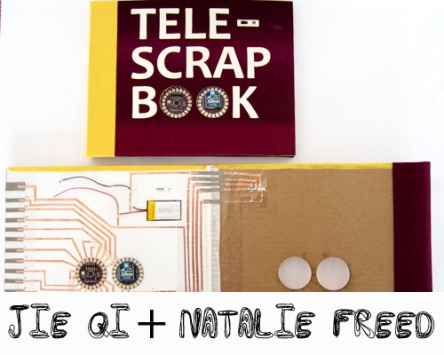
Telescrapbook The Telescrapbooks are remote-communicating electronic sticker books. They are constructed to look and feel as much as possible like traditional books, and to be completely customizable. The idea is for people to be able to design a personalized remote communication tool for themselves and someone they care about. http://www.nataliefreed.com/telescrapbook/na Vimeu
Team: Natalie Freed, Jie Qi, Adam Setapen

The Telescrapbooks are remote-communicating electronic sticker books. They are constructed to look and feel as much as possible like traditional books, and to be completely customizable and craft-able. The idea is for people to be able to design a personalized remote communication tool for themselves and someone they care about.
This project combines Communicreate, my first pass at a “remote communication construction kit,” and Jie Qi and Ed Baafi’s idea of electronic stickers. Jie and I brainstormed ways to fix the form factor problems, and decided to make the construction method sticker and papercraft — something familiar and easy, but also leaving tons of room for creativity. Adam joined us with ideas and mad coding skills, and together we made the Telescrapbooks and IOStickers.
Technologies: LilyPad Arduino, Xbee, paper electronics
Publications: Sticking Together: Handcrafting Personalized Communication Interfaces. IDC 2011. (pdf)
Each page has a sensor sticker footprint and an actuator footprint. These are connected via traces on the back of the page to a microcontroller.
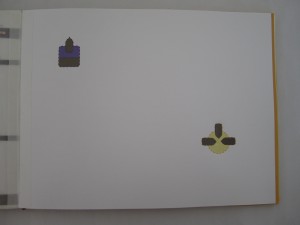
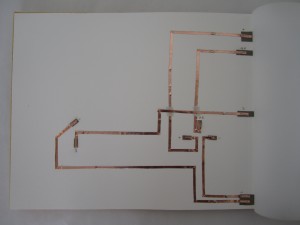
The back of the book has a page of IOStickers, electronic sensor and actuator stickers. These stickers can be placed on the footprints on the book pages.

To teach the concept, the book opens with a local connection page.

The pages following actually send and receive values from the other book. So when you affect a sensor on one page, the actuator on the corresponding page in the other book will activate. Currently the communication is limited to the range of the Xbee radios, but our next step is to make the books go through a computer or phone so they can be connected at any distance.
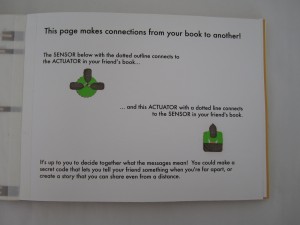
Here’s a page we decorated, covering the stickers. Jie made the white one and I made the messy one!
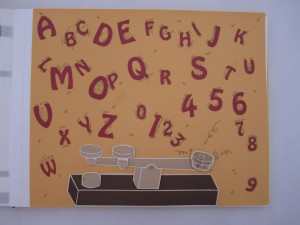
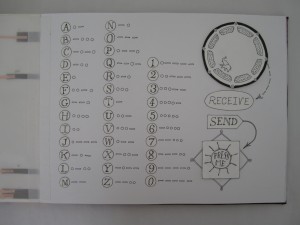
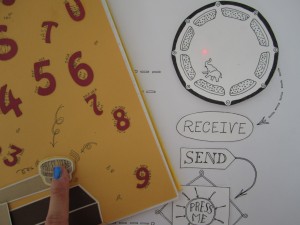
Here are some more pictures of the electronics.




So that we could let more people make their own pages, we designed Telepostcards, the greeting-card version. The cards have circuitry that goes from the sticker footprints to magnets on the back that snap onto a removable board containing all the communicating electronics.

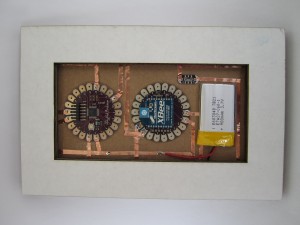

Here are a few of the cards our user test participants made.



Between Page and Screen explores the place of books as objects in an era of increasingly screen-based reading. The pages of this artist’s book contain no text—only abstract geometric patterns and a web address leading to a website, where the book may be read using any browser and a webcam. http://www.betweenpageandscreen.com/Between Page And Screen

An unlikely marriage of print and digital, Between Page and Screen chronicles a love affair between two characters, P and S. The book has no words, only inscrutable black and white geometric patterns that, when coupled with a webcam, conjure the written word. Reflected on screen, the reader sees him or herself with open book in hand, language springing alive and shape-shifting with each turn of the page.
The story unfolds through a playful and cryptic exchange of letters between P and S as they struggle to define their relationship. Rich with innuendo, anagrams, etymological and sonic affinities between words, Between Page and Screen revels in language and the act of reading.
Originally produced in a limited, letterpress edition of 12, Between Page and Screen is now available from Siglio Press.

10 PRINT CHR$(205.5+RND(1)); : GOTO 10 This book takes a single line of code–the extremely concise BASIC program for the Commodore 64 of the title–and uses it as a lens through which to consider the phenomenon of creative computing and the way computer programs exist in culture. http://nickm.com/post/2011/01/10-print-talks-galore/

Aunt Pepper The images of this book can be viewed just like in any other book, however, if in front of a webcam with the program installed, the songs beside the images of the play “Aunt Pepper” begin to play. Visit the project website here. More from Graphic Designer Manja Lekic: http://manjijak.tumblr.com/
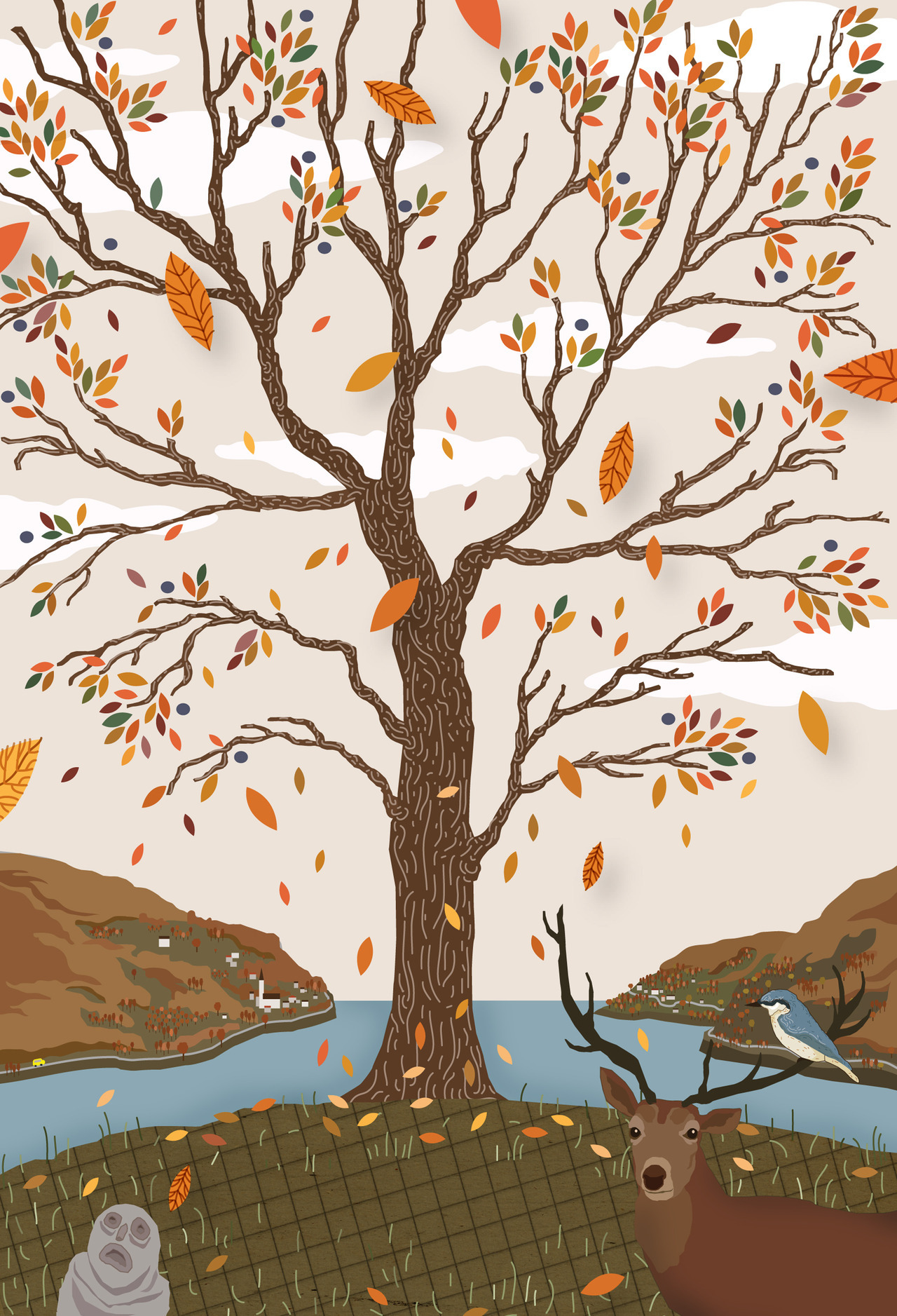

Simulant Portrait is an artist book that touches on themes of feminism, socialism, and materialism. It is also a performative text, a hybrid assemblage of visual and textual forms. The entire book is available to view online. http://www.artistsbooksonline.org/works/simp.xml
Project Statement by J. Drucker
In the late 1980s, I was still involved in working on the biography of Ilia Zdanevich (Iliazd), begun in 1985 when I was a Fulbright Fellow in Paris, working on my dissertation. That biography went through many iterations, and was finally left unpublished after Northwestern cancelled my contract. I had lost interest in the project, swept up in other matters, but the process of research and synthesis from documents and snippets of different kinds of materials had touched a nerve. I found this utterly satisfying to a certain obsessive streak. And so the structures of biography-writing, with all their connect-the-dots assumptions, varieties and ranges of sources and voices, evidence and documents, etc., were extremely appealing. Structurally, then, Simulant Portrait was conceived to mimic that process of research. Thematically the book was closer to older themes, of women and their lives, biographies and celebrity, the tensions of mass and literary culture in my own mind, and so on. The cyber-pulp aspect of the book is harder to place, as my proclivities were hardly sci-fi at that moment. Only that such notions were in the air, with Philip K. Dick (particularly the film Blade Runner) and William Gibson (rising star) occupying a certain popular imagination.
 |  |  |  |  |  |  |  |  |  |  |  |  |  |  |  |  |  |
 |  |  |  |  |  |  |  |  |  |  |  |  |  |  |

Speak This app is a platform with which to experiment with digital poetry. Users can enter their own text and interact with it, or they can feed the app with text from a Twitter stream. https://itunes.apple.com/app/speak/id406078727
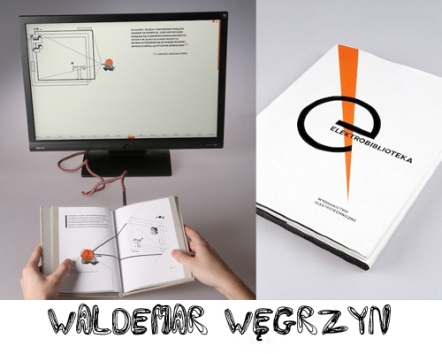
Electrolibrary This paper book that can be connected to the computer via USB cable. It is able to physically detect which page is currently open and send that information to the Electrolibrary website. By turning pages or touching given illustrations you can navigate through the website and get additional information such as hyperlinks, quotations, movies etc. You can also unplug the cable and read it like a normal book. http://thisispaper.com/Waldemar-Wegrzyn-Electrolibrary








Electrolibrary by Waldemar Węgrzyn
The project called "Electrolibrary" is my master degree diploma work
created in Multimedia Publications Studio at Academy of Fine Arts in
Katowice, Poland.
"I was interested in the phenomenon of a book perceived as a kind of interface, which has influenced the way we deal with information. I also wanted to shift the experience typical for print design to the field of digital media. One of the major inspirations was the manifesto "The topography of typography" published in 1923 by a graphic designer El Lissitzky, who has expected a book to be replaced with something he called "electrolibrary". It seems that his predictions came true.
The final result of the project is the paper book that can be connected to the computer via USB cable. It is able to phisically detect which page is currently open and send that information to the Electrolibrary website. By turning pages or touching given illustrations you can navigate through the website and get additional information such as hyperlinks, quotations, movies etc. Of course you can also unplug the cable and read it like a normal book.
The book was intended to be a single object, just for presentation. The great interest in my project that I encounter surprised me. I did not expect that at all, so maybe this project can be developed further."
"I was interested in the phenomenon of a book perceived as a kind of interface, which has influenced the way we deal with information. I also wanted to shift the experience typical for print design to the field of digital media. One of the major inspirations was the manifesto "The topography of typography" published in 1923 by a graphic designer El Lissitzky, who has expected a book to be replaced with something he called "electrolibrary". It seems that his predictions came true.
The final result of the project is the paper book that can be connected to the computer via USB cable. It is able to phisically detect which page is currently open and send that information to the Electrolibrary website. By turning pages or touching given illustrations you can navigate through the website and get additional information such as hyperlinks, quotations, movies etc. Of course you can also unplug the cable and read it like a normal book.
The book was intended to be a single object, just for presentation. The great interest in my project that I encounter surprised me. I did not expect that at all, so maybe this project can be developed further."

Hannibal Barca c. 259 BCE This handmade book chronicles the fable of Hannival Barca. While its textured paper and handdrawn images make it seem highly visceral, this book is currently only available to read and view online. http://www.uglyducklingpresse.org/barca-intro.html<< read the book >>

In Visible Cities uses digital code to select text and generate images. This book is inspired by Invisible Cities, a novel by Italo Calvino (translated by William Weaver), the mesostics of John Cage, the galactic tides of Juri Toomre, the typography of Iliazd, and an original poetic concept by Jean-Pierre Hébert. It features generative poetry composed by ideas translated into code, deliberate rule breaking through chance or bugs, and digital humor. http://jeanpierrehebert.com/index.html
jean-pierre hébert
|
"welcome to my website, structured as a simple book.
|
turn all its pages (using --next--> or <--previous-- at="at" i="i" the="the" top="top">
|
use the shortcuts, visit image galleries and high resolution galleries
|
you will find information on my work and my interests. enjoy your visit!"
|
independent artist, algorithmic art: computational drawings and mixed media since the 70's with a passion for lines. lives in santa barbara since 1985. cofounded the algorists in 1995.
|
awarded a pollock-krasner foundation grant in 2006, a david bermant foundation grant in 2008-9, and in 2012 the acm siggraph distinguished artist award for lifetime achievement in digital art.
|
digital art collections: block museum (northwestern university, chicago), victoria and albert museum (london).
|
community activities: artist in residence at the kavli institute for theoretical physics (kitp) at the university of california in santa barbara (ucsb).
|
recent: drawing with the mind, solo show at the santa barbara contemporary arts forum more information. victoria & albert museum in london (digital pioneers). decordova museum in lincoln, ma drawing with code exhibition of the anne and michael spalter collection.
|
current: kitp at ucsb sciart 2011 annual group show.
|
soon: kitp at ucsb annual group show sciart 2012: mysterious.
|

16 Months of Drawing Exercises in Microsoft Excel “Microsoft Excel is a program designed to track and compute information, but here I am using Excel as a drawing tool. Each drawing is in a new ‘worksheet’. The drawings were made by changing cell preferences for background color, fill pattern, and border styles.” http://www.danielleaubert.com/print/exceldrawings_16monthsbook.html
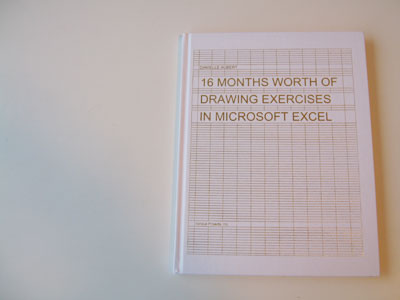 |
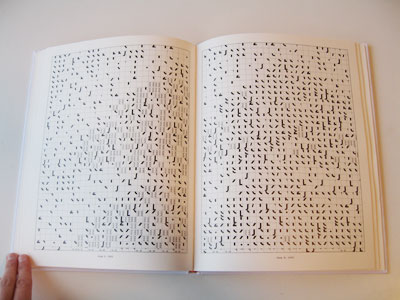 |
|
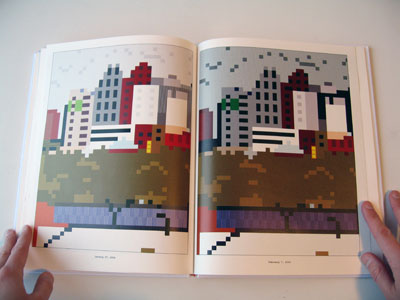 |
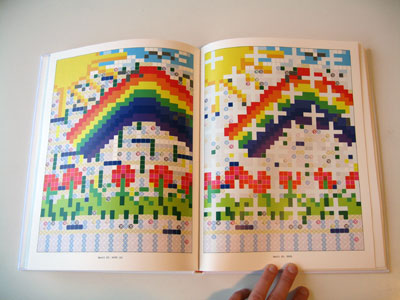 |
|
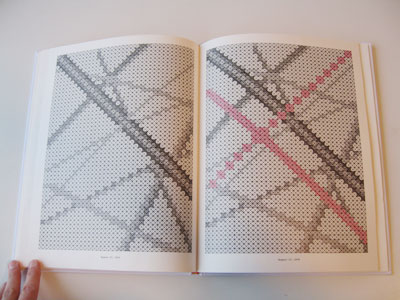 |
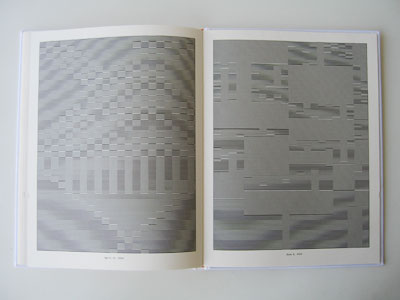 |
|
| Microsoft Excel is a program designed to track and compute information, but here I am using Excel as a drawing tool. These drawings are a part of a series that I executed on an irregular daily basis for 16 months. Each drawing is in a new 'worksheet,' which is automatically set up as a grid. The drawings were made by changing cell preferences for background color, fill pattern, and border styles and from time to time inserting 'comment' boxes and letters or words. Other manifestations of these drawings are 58 Days Worth of Drawing Exercises in Microsoft Excel as Rendered for Web and Animated Daily Excel Drawings. The book was published by Various Projects, in New York and is for sale at their shop, Project No. 8 or at the New Museum bookstore. (2005-2008) | ||
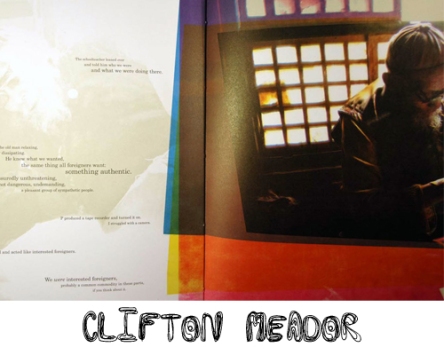
Heart “I traveled to Kham, a historically Tibetan area, as a member of an interdisciplinary study group. We were there to study traditional Tibetan book production. This book starts with the mantra from the Heart sutra, and structures a travel experience around it.” http://www.cliftonmeador.com/artists' book:
Several of these links point directly to the Artists' Books Online site.
How Books Work Julie Chen and Clifton Meador {2010}
Three Tibetan Bookstores {2008}
heart {2008}
Rocks, Literati, & Invasion {2007}
Kora {2007}
Avalanche {2007}
Bad {2006}
Tourist/Refugee {2005}
Nameless Dead {2004}
Crossing the Oxus {2001}
Whisky Defense {2001}
Memory Lapse {1999}
Natyurmort {1997}
Long Slow March {1995}
Positive Produce and Negative Books {1995}
Nutritional Disease Throw Rugs {1995}
A.A.A.R.P. {1994}
A Long Walk {1995}
Foxtrot Oscar Lima Lima Yankee {1991}
Sea Change {1990}
Massive Infection {1990}
Anecdote of the Jar {1989}
Mighty Fortress {1989}
Greenness {1988}
Stampland {1988}
Rising Converging {1988}
New Doors {1985}
Doom {1984}
Great Men of the Modern Age {1982}
Short Letter to My Friends {1980}

The Case for the Burial of Ancestors Book Two is the second book of a trilogy in which Zelevansky developed a rich structure of symbols, signs, myths and word play. It includes a computer game, Swallows, on floppy disk. http://printedmatter.org/catalogue/moreinfo.cfm?title_id=2042Paul Zelevansky
The Case for the Burial of Ancestors. Book 2 : Genealogy
New York, NY: Zartscorp, Inc.. 1986
Synopsis: This is the second book of a trilogy in which Zelevansky has developed a rich structure of symbols, signs, myths and word play with which to describe the Hegemonions, an ancient desert civilization – the people of the book. It includes a computer game, Swallows, on floppy disk and a glassine envelope containing sixteen of forty stamps of which each is a reduced reproduction of one of the Forty Cards of the Puppeteer's Portable Traveling Pack. 'GENEALOGY,' forms an essential link between the creationist concerns of Book I (GEOGRAPHY) and the scientific concerns of Book III (THE HISTORY OF THE H TABERNACLE IN EXILE)." --the Artist.
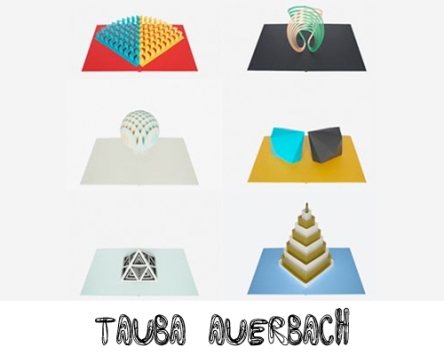
[2,3] is an oversized pop-up book featuring six die-cut paper sculptures that unfold into elaborate forms. Engineered by the artist, each “page” opens into a constructed object, intricately conceived so that the large-scale paper works—some up to 18” tall—can be collapsed totally flat. Click here to view additional images. taubaauerbach.com/

Preliminary Materials for a Theory of the Young-Girl Available to view for free online from publisher triplecanopy, this is an excerpt from Tiqqun’s book of the same title, which dissects the impossibility of love under Empire. Tracing consumer society’s colonization of youth and sexuality through the Young-Girl’s “freedom” (in magazine terms) to do whatever she wants with her body, Tiqqun exposes the rapaciously competitive and psychically ruinous landscape of modern love. http://canopycanopycanopy.com/16/preliminary_materials_for_a_theory_of_the_young_girl
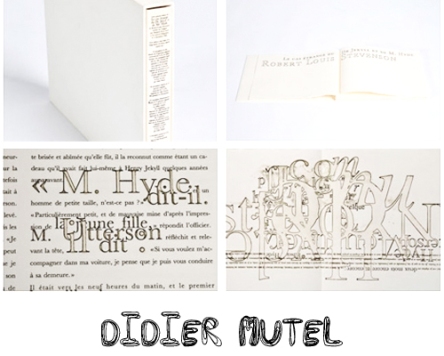
The Strange Case of Dr. Jekyll and Mr. Hyde embodies the change/dissolution of the title character in the text. As Mr. Hyde takes over, words grow, distort, and overpower the narrative. http://www.atelierdidiermutel.com/


Ecce Video is a unique accordion-style book containing eight poems in Italian by Magrelli (winner of the Mondello Prize, the Viareggio Prize, and the Montale Prize) with illustrations by Lucio Passerini. http://www.alessandrozanella.it/wordpress/i-libri/ampersand/ecce-video/
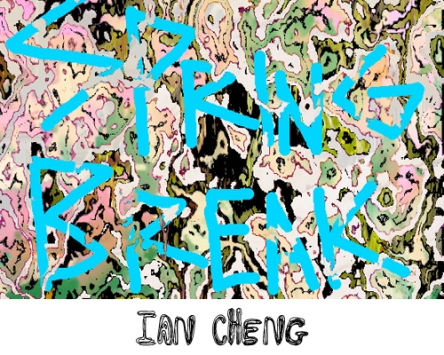
Spring Break An overlay of uniquely generated digital images that camouflage texts on the page from the likes of neo-conservative historians, drunken students cavorting on Miami’s South Beach, and the author, Spring Break is an experimental e-book that weaves elements of design, poetry, and incantatory idioms into a digital book that unfolds like a flipbook moving at the speed of a mellifluous hallucination. https://itunes.apple.com/us/book/spring-break/id434526282?mt=11

To listen to the audio of Gretchen Henderson’s keynote talk, “This is (Not) a Book: Melting Across Bounds,” click here
Links from Martin Antonetti’s Presentation of Web-Based and Digital Artists Books:
Projects from Les Editions Volumiques in Paris
- http://volumique.com/v2/?portfolio=12
- http://volumique.com/v2/?portfolio=26
- http://volumique.com/v2/?portfolio=08
- http://volumique.com/v2/?portfolio=daniel-johnstons-space-ducks-sur-ipad&lang=en
The Electrolibrary by Waldek Wegrzyn
The Computational Sketchbook by Jie Qi
Pax by Stuart Moulthrop. Between e-literature, games, and artists books…
Strange Rain by Eric Loyer. An iPad app that combines games and digital storytelling
Between Page and Screen by Amaranth Borsuk
“Mediabooks” by Mikail Karasik
- http://www.artists-book.net/ENG/Selected/Samozveri.html
- http://www.artists-book.net/ENG/Selected/Affirmer.html
This is Nick Montfort's blog about interactive narrative, imaginative and poetic digital writing, the material history of computational media, video and computer games, and other stuff he likes. Nick has a plain old website, too.
Radical Books of 2012 (2/7)
How It Is in Common Tongues
Cited from the Commons of digitally inscribed writing by John Cayley & Daniel C. Howe
NLLF [Natural Language Liberation Front] · 296 pagesSome seek diamonds in the rough on the Web; others mine from this lode of language mud and darkness. This profound document was fashioned with snippets of pages, with the search engine, and with the novel first publised as Comment c’est – using all of them quite perversely. Samuel Beckett’s 1964 How It Is describes a person moving and not moving through the mud, alone, not alone, and then once more alone. Cayley and Howe, bending the service known as Google to their literary purposes, have located every phrase of the novel on Web pages where no reference to Beckett is made. For instance, the first words, “how it was I quote,” are found in a New York Times excerpt from Elie Wiesel’s And The Sea is Never Full. The phrase is provided, the URL is given in a footnote … and the same is done for every other phrase in How It Is. The result is an edition of Beckett’s book made of text that was literally found on the Web. The only thing funnier will be the Beckett Estate’s response.
10 PRINT “HAPPY NEW YEAR”
Happy new year!
A few updates related to our book 10 PRINT CHR$(205.5+RND(1)); : GOTO 10 …
Booksellers had some problems keeping the book in stock in recent weeks. The MIT Press is addressing this by printing more copies.
We learned in November, and were recently reminded by Finnish scener and programmer of one-liners viznut, that there is a pre-Commodore 64 version of the program. It’s in a fairly obvious place, too: The VIC-20 User’s Manual, on page 102. The program is identical to the first variant in our book (Variant 1982) except that the line numbers are 10, 20, and 30 instead of 10, 20, and 40. This wasn’t a big surprise to us, as we knew since early in the process of writing the book that the program worked not only on the Commodore 64 but also on the VIC-20 and the PET. It would have been nice to have documented this variant in the book, of course.
mjcohenw on Hacker News states that the program originated even earlier:
Finally, I’ll note that 10 PRINT appears as one of the “creation stations” at the 2013 Modern Langauge Association Convention. The exhibit it’s in, Avenues of Access: An Exhibit & Online Archive of New ‘Born Digital’ Literature, will be in room 312 in the Hynes Veterans Memorial Convention Center. Exhibit times are:
Thursday, 3 January, 12 Noon to 7:00 p.m.
Friday, 4 January, 9:00 a.m. to 7:00 p.m.
Saturday, 5 January, 9:00 a.m. to 7:00 p.m.
The exhibit closes on Saturday afternoon and will not be open on Sunday.
There will be a reading to accompany the exhibit on Friday night, 8 p.m. to 10 p.m., at Emerson College’s Bordy Theatre, 216 Tremont Street. 10 PRINT will be part of that and will be presented by five of the book’s co-authors.
A few updates related to our book 10 PRINT CHR$(205.5+RND(1)); : GOTO 10 …
Booksellers had some problems keeping the book in stock in recent weeks. The MIT Press is addressing this by printing more copies.
We learned in November, and were recently reminded by Finnish scener and programmer of one-liners viznut, that there is a pre-Commodore 64 version of the program. It’s in a fairly obvious place, too: The VIC-20 User’s Manual, on page 102. The program is identical to the first variant in our book (Variant 1982) except that the line numbers are 10, 20, and 30 instead of 10, 20, and 40. This wasn’t a big surprise to us, as we knew since early in the process of writing the book that the program worked not only on the Commodore 64 but also on the VIC-20 and the PET. It would have been nice to have documented this variant in the book, of course.
mjcohenw on Hacker News states that the program originated even earlier:
I discovered this on my Commodore PET probably about 1980 and presented it at a users’ group meeting (in the Los Angeles area). I have no way to prove this right now, but I swear that this is true.So, there’s a testament to the program being written and shared on the PET even earlier. That it comes from human memory, and not from some print source, should be no surprise to readers of 10 PRINT.
Finally, I’ll note that 10 PRINT appears as one of the “creation stations” at the 2013 Modern Langauge Association Convention. The exhibit it’s in, Avenues of Access: An Exhibit & Online Archive of New ‘Born Digital’ Literature, will be in room 312 in the Hynes Veterans Memorial Convention Center. Exhibit times are:
Thursday, 3 January, 12 Noon to 7:00 p.m.
Friday, 4 January, 9:00 a.m. to 7:00 p.m.
Saturday, 5 January, 9:00 a.m. to 7:00 p.m.
The exhibit closes on Saturday afternoon and will not be open on Sunday.
There will be a reading to accompany the exhibit on Friday night, 8 p.m. to 10 p.m., at Emerson College’s Bordy Theatre, 216 Tremont Street. 10 PRINT will be part of that and will be presented by five of the book’s co-authors.
Radical Books of 2012 (1/7)
The Oregon Trail is the Oregon Trail
Gregory Sherl
Mud Lucious Press · 65 pagesConsciousness wobbles between the “real world” of Barry Manilow concerts, streetscapes that look like Frogger, and private Facebook messages on the one hand and a fabled simulation bleeding beyond the phosphors of the computer-connected CRT television on the other. Amid tender moments featuring the wife, child #1, and child #2, these poems also offer reminders of the political context in which Westward expansion was undertaken. “The Oregon Trail 2 Starring Mel Gibson Directed by Mel Gibson” notes, for instance, “We have Manifest Destiny in our cocks.” This book about the American journey, not the destination, may appear to be a nostalgic romp. (Perhaps the book’s dedication, “FOR YOUTH,” and the theme of adult responsibilities invites such an attitude.) There is no home to ache over, though, in these 39 poems that join intimate imagination to a famous if floppy American document, showing that however personal or national memory flows past, in whatsoever form, you can’t ford the same river twice.
The Gorge in Review, and in Remix
Leonardo Flores has now written 22 posts (one each day, as is his wont over at “I ♥ E-Poetry”) on Taroko Gorge and its various remixes.
Quite a critical outpouring, considering that Taroko Gorge was originally a one-day project!
Leonardo also presents TransmoGrify, another remix of Taroko Gorge that narrates the programming and remixing of these 22 poem generators, producing stanzas such as this one:
Quite a critical outpouring, considering that Taroko Gorge was originally a one-day project!
Leonardo also presents TransmoGrify, another remix of Taroko Gorge that narrates the programming and remixing of these 22 poem generators, producing stanzas such as this one:
Mark inverts the line.With the absolute ♥ of the e-poetry of life butchered out of their own bodies good to eat a thousand years.
Sonny Rae experiments.
Judy intervenes upon the variable.
Purple Blurb Spring 2013: McIntosh, Di Blasi, Henderson
Thanks to the good work of guest organizer Gretchen Henderson, the Purple Blurb schedule for Spring 2013 is already set! I hope to see you locals at some or all of them.
All Spring 2013 events are Mondays at 5:30pm in MIT’s room 14E-310. This is in the East wing of Building 14, across the building’s courtyard from the Hayden Library. Building 14 is not part of the Media Lab Complex. The Spring 2013 schedule is thanks to guest organizer Gretchen Henderson.

Jason McIntosh is an independent games critic, designer, and scholar. During the previous decade, he produced “The Gameshelf”, a public-access TV series examining both tabletop and digital games, and “Jmac’s Arcade,” a set of video monologues on growing up within the arcade culture of the 1980s. More recently, he’s taught a game-studies lab at Northeastern University, published the XYZZY Award-winning work of interactive fiction “The Warbler’s Nest”, crafted the iPad edition of the tabletop game “Sixis” by Chris Cieslik, and worked as a game-design consultant for other clients. He continues to write game-criticism essays on The Gameshelf’s blog, and produces the occasional episode of the podcast series “Play of the Light”, which he co-hosts with Matthew Weise. His website collecting all this stuff may be found at jmac.org

Debra Di Blasi is a multi-genre, multimedia author of six books, including The Jirí Chronicles & Other Fictions, Drought & Say What You Like, and Skin of the Sun. Awards include a James C. McCormick Fellowship in Fiction from the Christopher Isherwood Foundation, Thorpe Menn Book Award, Cinovation Screenwriting Award, and Diagram Innovative Fiction Award. Her fiction is included in a many leading anthologies of innovative writing and has been adapted to film, radio, theatre, and audio CD in the U.S. and abroad. Her essays, art reviews and articles can be found in a variety of international, national and regional publications. She frequently lectures on the intersection of literature and technology and is working on a nonfiction book on related topics.

Gretchen E. Henderson is a Mellon postdoctoral fellow at MIT and a metaLAB fellow at Harvard, who writes across genres, the arts, and music to invigorate her critical and creative practices. She is the author of two novels, The House Enters the Street and Galerie de Difformité (winner of the Madeleine Plonsker Prize), a collection of nonfiction, On Marvellous Things Heard, and a poetry chapbook, Wreckage: By Land & By Sea. Among other projects at MIT, she is working on Ugliness: A Cultural History (for Reaktion Books), while continuing the collaborative deformation of Galerie de Difformité: a print book that is interfacing with the history and future of the book, networked online, inviting readers to participate in its (de)formation across media.
All Spring 2013 events are Mondays at 5:30pm in MIT’s room 14E-310. This is in the East wing of Building 14, across the building’s courtyard from the Hayden Library. Building 14 is not part of the Media Lab Complex. The Spring 2013 schedule is thanks to guest organizer Gretchen Henderson.
February 11, 5:30pm in 14E-310
Jason McIntosh
Presents the Interactive Fiction “The Warbler’s Nest”

Jason McIntosh is an independent games critic, designer, and scholar. During the previous decade, he produced “The Gameshelf”, a public-access TV series examining both tabletop and digital games, and “Jmac’s Arcade,” a set of video monologues on growing up within the arcade culture of the 1980s. More recently, he’s taught a game-studies lab at Northeastern University, published the XYZZY Award-winning work of interactive fiction “The Warbler’s Nest”, crafted the iPad edition of the tabletop game “Sixis” by Chris Cieslik, and worked as a game-design consultant for other clients. He continues to write game-criticism essays on The Gameshelf’s blog, and produces the occasional episode of the podcast series “Play of the Light”, which he co-hosts with Matthew Weise. His website collecting all this stuff may be found at jmac.org
March 11, 5:30pm in 14E-310
Debra Di Blasi
“Skin of the Sun: Five Iterations Toward Human As Novel”
Followed by a discussion of the literary publisher’s role in the 21st Century

Debra Di Blasi is a multi-genre, multimedia author of six books, including The Jirí Chronicles & Other Fictions, Drought & Say What You Like, and Skin of the Sun. Awards include a James C. McCormick Fellowship in Fiction from the Christopher Isherwood Foundation, Thorpe Menn Book Award, Cinovation Screenwriting Award, and Diagram Innovative Fiction Award. Her fiction is included in a many leading anthologies of innovative writing and has been adapted to film, radio, theatre, and audio CD in the U.S. and abroad. Her essays, art reviews and articles can be found in a variety of international, national and regional publications. She frequently lectures on the intersection of literature and technology and is working on a nonfiction book on related topics.
April 8, 5:30pm in 14E-310
Gretchen E. Henderson
“Galerie de Difformité:The Book as Body, The Body as Book”
Followed by an OPEN MIC!

Gretchen E. Henderson is a Mellon postdoctoral fellow at MIT and a metaLAB fellow at Harvard, who writes across genres, the arts, and music to invigorate her critical and creative practices. She is the author of two novels, The House Enters the Street and Galerie de Difformité (winner of the Madeleine Plonsker Prize), a collection of nonfiction, On Marvellous Things Heard, and a poetry chapbook, Wreckage: By Land & By Sea. Among other projects at MIT, she is working on Ugliness: A Cultural History (for Reaktion Books), while continuing the collaborative deformation of Galerie de Difformité: a print book that is interfacing with the history and future of the book, networked online, inviting readers to participate in its (de)formation across media.
Someone Hearts Taroko Gorge
Leonardo Flores of I ♥ E-Poetry is writing about 18 remixes of Taroko Gorge, one each day for the next 18 days.
A Poetry Class for 36,000
December 10, 5:30pm in MIT’s 6-120
Al Filreis
Teaching Modern & Contemporary American Poetry to 36kAl Filreis has taught his “ModPo” course at Penn for years; in Fall 2012 he offered a 10-week version of the course online, via Coursera, to more than 36,000 students. The course, as in its previous versions, does not include lectures, being based instead on discussion – the collaborative close readings of poems. The course grows out of Filreis’s work at the Kelly Writers House; he has been Faculty Director of this literary freespace since its founding in 1995. Filreis is also co-founder of PennSound, the Web’s main free archive of poetry readings, publisher of Jacket2 magazine, and producer and host of “PoemTalk,” a podcast/radio series of close readings of poems. In conversation with Nick Montfort, Filreis will discuss ModPo and his perspective on writing, teaching, and digital media.
Filreis is Kelly Professor of English and Director of the Center for Programs in Contemporary Writing at the University of Pennsylvania. He is the author of Wallace Stevens and the Actual World, Modernism from Right to Left, Counter-Revolution of the Word: The Conservative Attack on Modernism, 1945-60, and other works. He was chosen as Pennsylvania Professor of the Year by the Carnegie Foundation in 2000.
Co-sponsored by the SHASS Dean’s Office and the Literature Section.
All Purple Blurb events are free and open to the public. The Purple Blurb series is supported by the Angus N. MacDonald fund and Writing and Humanistic Studies.
What’s the Story on Digital Media?
I generally will reply to any email messages that was personally
written to me and which requests a reply. Perhaps because I wrote for my
college newspaper, I’m inclined to try to help student journalists when
I can. Sometimes, though, the best suggestions I can offer are ideas
about how to rethink the basic approach and find a real story, rather
than the sought-after quotations. As when, recently, I wrote basically
this in reply to some extremely general questions about digital media
and changes in the way we communicate – perhaps prompted by a class
assignment rather than part of work toward an article for publication:
This student didn’t seem interested in approaching the topic differently and more productively, and asked instead if I could recommend someone who would provide quotes. That’s not a surprise – it’s the typical nature of this exchange, after all, and not a desire to roast any (unnamed) person, that motivates me to post this. It does go to show that whether you use in-person interviewing, an analog land-line phone, or email, you can miss gaining insight in the same way.
Grouping together Facebook, blogs, and text messages on one side and letter-writing on the other isn’t really sound, since it assumes that Facebook, a blog, and a text message are the same sort of thing and that a letter is a different sort of thing. Is a letter typed on a word processor the same as or different from a hand-written letter? Is one a digital media letter and the other pre-digital? Why is publishing a long, public blog post at all like sending a text message to a friend?The paragraph marked with *, of course, is just as true for computational platforms (the focus of the platform studies approach and the MIT Press Platform Studies series) as it is of communications systems, and it’s one of the core ideas behind platform studies and what it comprehends.
Your questions also suggest that people are constantly making choices between using digital media and traditional media. We live in a media ecology in which old media are not simply replaced by new. There are many ways to communicate, but we very seldom choose one over the other. I suppose there are circumstances under which you might send a friend a postcard, for instance, but I find it very unlikely that you’d make a direct and conscious decision to do that instead of sending that friend a text message.
Your questions also seem to assume that new media technologies just appear and that we are influenced by them, because you ask only about the effects of these technologies. Facebook was not given to the Earth by aliens, though. It was developed by people based on existing ideas about communication. The same can be said for the Web and any other digital communication system. Someone who is interested in knowing why communication online is the way that it is will never figure that out just by asking about how Facebook influences the way people write. It’s also necessary to understand why Facebook came to be the way it is, in terms of its original motivation and development and down to specific questions (such as your last one) related to particular features.*
I would suggest focusing on a particular digital media system and asking about how it arose, how it is used, and what’s special about it — not just in relation to some non-digital means of communicating, but overall. It can be worthwhile to ask what niche such a system has in the media ecology: What does it offer in particular that is better than other media channels? Then, you can see how people use language within that channel in interesting ways that is revealing in terms of culture, cognition, and so on. The people who study these systems successful in the humanities and social science, and those who build them and do well at it, take this sort of approach, and there are certainly interesting stories that result about why certain systems are successful in certain ways and how they are actually used.
This student didn’t seem interested in approaching the topic differently and more productively, and asked instead if I could recommend someone who would provide quotes. That’s not a surprise – it’s the typical nature of this exchange, after all, and not a desire to roast any (unnamed) person, that motivates me to post this. It does go to show that whether you use in-person interviewing, an analog land-line phone, or email, you can miss gaining insight in the same way.
Farking, Processing, and 10 PRINT
The book 10 PRINT CHR$(205.5+RND(1)); : GOTO 10 (and the program) have been discussed as “cool” on Fark. (I was hoping for a Photoshop contest with the program’s output, but this is nice, too…)
One of my co-authors, Casey Reas, has issued a 10 PRINT design challenge to the Processing community. There’s already been one program written in reply.
One of my co-authors, Casey Reas, has issued a 10 PRINT design challenge to the Processing community. There’s already been one program written in reply.
Slashdot Examines Slash, Backslash of 10 PRINT
Slashdot is on the case of 10 PRINT, too, with the usual diagonal PETSCII lines as well as slashes and backslashes. The Slate review and the code are the main topics of discussion so far, but perhaps some are also beginning to dig into the book or PDF.
Redditors Redact and Revise 10 PRINT
There’s lively discussion of the 10 PRINT book and the 10 PRINT program, 10 PRINT CHR$(205.5+RND(1)); : GOTO 10, (via the Slate review) over at Reddit. The Enterprise Java port of the program, contributed early on, is truly classic.
Review of 10 PRINT in Slate, New Ports/Variants
Geeta Dayal reviewed 10 PRINT in Slate.
As far as I know, this is the first published review of the book, and I
greatly appreciate how it traces the discussion of mazes and other
topics, pointing out the many cultural and well as technical
touchstones.
Over at Stack Overflow they have a nice thread going with several shell scripts that implement 10 PRINT.
Daniel Haehn has written a 3D version of the 10 PRINT program in WebGL.
And my lab’s server is back up after a power outage here in Cambridge, MA, so the PDF of the book that was hosted there is once more available.
Over at Stack Overflow they have a nice thread going with several shell scripts that implement 10 PRINT.
Daniel Haehn has written a 3D version of the 10 PRINT program in WebGL.
And my lab’s server is back up after a power outage here in Cambridge, MA, so the PDF of the book that was hosted there is once more available.
10 PRINT Event, Post, Site, Photos
Our event at the Boston Cyberarts Gallery
(with me – Nick Montfort – Patsy Baudoin and Noah Vawter) went very
well, with the gallery full for the salon and people willing up after
the discussion to come program on the two Commodore 64s that we brought.
There were some fascinating variants developed, too. Thanks to George
for setting this up for us and to Dan and Bill for getting the space set
so that the C64s could be powered up and connected to a projector.
Lev Manovich, one of the editors of the Software Studies series in which our book appears, writes of it:
Finally, Casey Reas, our co-author and the designer of the book, has posted a set of photos of the 10 PRINT book. These are very effective in showing the care that Casey took in putting together the book, and how well it communicates the insights we reached together – and why you may enjoy reading the physical, printed 10 PRINT.
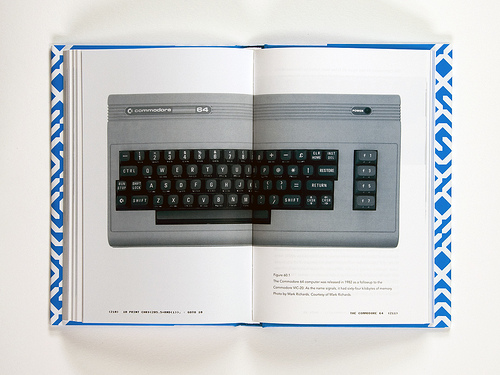
Lev Manovich, one of the editors of the Software Studies series in which our book appears, writes of it:
10 PRINT was “coded” by 10 writers. However, rather than producing yet another academic anthology made up by independent parts, they made a coherent single “intellectual software” which executes beautifully.We have a site for the book now at http://10print.org – you can download the entire contents, Creative Commons licensed, from the site there in a 50MB PDF. We’re happy to follow up on how the original program was shared in the 1980s by sharing our book in this way.
Finally, Casey Reas, our co-author and the designer of the book, has posted a set of photos of the 10 PRINT book. These are very effective in showing the care that Casey took in putting together the book, and how well it communicates the insights we reached together – and why you may enjoy reading the physical, printed 10 PRINT.

10 PRINT at the Boston Cyberarts Gallery
As seen on Bruce Sterling’s blog, we have an 10 PRINT (or, to be precise, a 10 PRINT CHR$(205.5+RND(1)); : GOTO 10)
event tomorrow, Wednesday, here in Boston. The Boston Cyberarts Gallery
(formerly AXIOM) is located in the Green Street T station on the Orange
Line; the event’s at 7:30pm.
An evening to celebrate the publication by MIT Press of 10 PRINT CHR$(205.5+RND(1)); : GOTO 10. This book takes a single line of code-the extremely concise BASIC program for the Commodore 64 inscribed in the title-and uses it as a lens through which to consider the phenomenon of creative computing and the way computer programs exist in culture. The ten authors of this collaboratively written book, treat code not as merely functional but as a text-in the case of 10 PRINT, a text that appeared in many different printed sources-that yields a story about its making, its purpose, its assumptions, and more.
They consider randomness and regularity in computing and art, the maze in culture, the popular BASIC programming language, and the highly influential Commodore 64 computer.
Nick Montfort will start off the evening leading a discussion among co-authors and the audience about this celebrated piece of software. And there will be a short hackathon.
ATNE Salons are informal discussions on art/technology topics. At each event, we start the discussion with a presentation by an expert in the field who’ll provide context and raise provocative questions. Next, with the help of a moderator, we turn the debate over to you. Share your ideas, discover new ones and participate in analytical discourse and artistic cross-pollination.
About Art Technology New England
ATNE is a member-run organization whose purpose is to foster existing and new collaborations in the New England art and technology communities, including non-profit, academic & corporate entities, as well as individuals.
When: Wednesday, November 28th, 7:30pm
Where: Boston Cyberarts Gallery,
141 Green St.,
Jamaica Plain, MA 02130
Free event!
RSVP to info [at] atne.org
www.atne.org
The People’s Republic of Interactive Fiction … Today
Boston-Area IF group The People’s Republic of Interactive Fiction (PR-IF) is set to meet at 6:30pm today in my lab, The Trope Tank (MIT’s room 14N-233). We’ll check out some of the winners of the 2012 Interactive Fiction Competition, the 18th annual Comp, which recently concluded. Congratulations to Marco Innocenti for his 1st-place Andromeda Apocalypse, to the anonymous author of Eurydice (which took 2nd), and to Jim Munroe, for Guilded Youth, which was 3rd – and to all of the other winners!
Submit to E-Poetry!
The deadline for E-Poetry 2013 (to take place in London, at Kingston University) is almost here – sumissions are due December 1. The festival will take place June 17-20.
Lede, Based on a True Story
Sometimes I encounter language that sounds like it was computer-generated, or that sounds like it would be even better if it was. Hence, the slapdash “Lede,”
which is based on the first sentence (no, not the whole first
paragraph) of a news story that was brought to my attention on ifMUD.
This very simple system does incorporate one minor innovation, the function “fresh(),” which picks from all but the first element of an array and swaps the selection out so that it ends up at the beginning of the array. This means that it doesn’t ever pick the same selection twice in a row.
Happy Thanksgiving, my fellow Americans.
This very simple system does incorporate one minor innovation, the function “fresh(),” which picks from all but the first element of an array and swaps the selection out so that it ends up at the beginning of the array. This means that it doesn’t ever pick the same selection twice in a row.
Happy Thanksgiving, my fellow Americans.
The Computer Museum is … Alive!
A great story on the Living Computer Museum in Seattle, where they have computers … that work!
Palindromes, the Next Best Thing to Rounded Corners
Mark Saltveit, palindromist and comedian, delivers a compelling “CHAD” talk on the e-levels of palindromes
and his new approaches of Palindromics and its natural cultish
extension, Scinegenics. In his talk, he covers some palindrome history
and the development of weaponized palindromes. Although Mark is a
letterist, he mentions a classic word-unit palindrome from the book of
Exodus, “AHYH ASHR AHYH,” or “ehyeh asher ehyeh,” or, to rend it into a
Popeye-esque English, “yam whaddaye yam!”
Judy Malloy on 10 PRINT
Over on her site Authoring Software, longtime e-lit author and BASIC programmer Judy Malloy has written a news story about the release of 10 PRINT CHR$(205.5+RND(1)); : GOTO 10. I’m quoted, along with co-authors Mark Marino and Jeremy Douglass.
Also, the book has made its way further out into the world – both the Harvard Book Store and the The MIT Press Book store now have it in stock.
Also, the book has made its way further out into the world – both the Harvard Book Store and the The MIT Press Book store now have it in stock.
Statistics Outta My Face
Ben Grosser created Facebook Demetricator,
a tool that removes counts from Facebook, so that instead of displaying
“14,836 people like this” your interface will simply say “people like
this.”
I love the concept. I haven’t seen it in action myself, because of my use of a manually-implemented “DeFacebookizer” that, rather than enmeshing me in the most direct possible corporate system of social control and structure, leaves me with only the heterogeneous, diverse, and open communications from people on the World Wide Web. The Web is not a pure wonderland, though. These sorts of communications are, of course, also continually subject to statistical analysis and displays of counts – how many comments on a blog post, for instance. To intervene in the count-obsession of digital media, it makes sense to go to where it is most prominent.
Grosser discusses his deaugmentation of Facebook in an interview with Matthew Fuller.
I love the concept. I haven’t seen it in action myself, because of my use of a manually-implemented “DeFacebookizer” that, rather than enmeshing me in the most direct possible corporate system of social control and structure, leaves me with only the heterogeneous, diverse, and open communications from people on the World Wide Web. The Web is not a pure wonderland, though. These sorts of communications are, of course, also continually subject to statistical analysis and displays of counts – how many comments on a blog post, for instance. To intervene in the count-obsession of digital media, it makes sense to go to where it is most prominent.
Grosser discusses his deaugmentation of Facebook in an interview with Matthew Fuller.
The 2013 ELO Conference in Paris
The Electronic Literature Organization’s 2013 conference will be in Paris:
Chercher le Texte:
Chercher le Texte:
Locating the Text in Electronic Literature
The Electronic Literature Organization (http://eliterature.org), the leading organization devoted to electronic literature, announces its 2013 conference to be held in Paris, France, September 24-27, 2013, in collaboration with Université Paris 8. Proposals are welcome on topics within electronic literature, including but not limited to:The website is being prepared now, but a call for proposals (with further information) is already out. The deadline is December 31, 2012.
- Digital culture
- Code and software studies
- Digital art
- Translation of electronic literature
- E-literature and the body
- Digital poetics
- Digital storytelling
- Mobile/locative media
10 PRINT Exhibit, Reading
Our book 10 PRINT CHR$(205.5+RND(1)); : GOTO 10
has been printed and bound and is making its way to bookstores now.
It’s featured in a current exhibit at Hampshire College, and three of us
ten co-authors did a reading to celebrate the release at the Harvard Book Store yesterday, where the first copies were available.
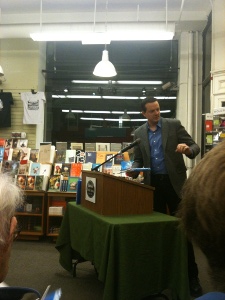 Our reading at the Harvard Book Store drew a sizable crowd, including
MIT colleagues from Comparative Media Studies / Writing and Humanistic
Studies and the Literature section; comrades in the People’s Republic of
Interactive Fiction, librarians, and local free software folks and
hackers, among others. The three of us read some short excerpts from the
book and discussed the project, first with each other and then in
response to questions from the audience. Several people assumed that the
book was a collection of individually-authored articles, which is not a
surprise, since that’s usually how a book like this is done. So we
spent some time explaining the process of collaborative authorship that
we used. The photos here are of me (Nick Montfort) on the left, then of
Patsy Baudoin and Noah Vawter.
Our reading at the Harvard Book Store drew a sizable crowd, including
MIT colleagues from Comparative Media Studies / Writing and Humanistic
Studies and the Literature section; comrades in the People’s Republic of
Interactive Fiction, librarians, and local free software folks and
hackers, among others. The three of us read some short excerpts from the
book and discussed the project, first with each other and then in
response to questions from the audience. Several people assumed that the
book was a collection of individually-authored articles, which is not a
surprise, since that’s usually how a book like this is done. So we
spent some time explaining the process of collaborative authorship that
we used. The photos here are of me (Nick Montfort) on the left, then of
Patsy Baudoin and Noah Vawter.

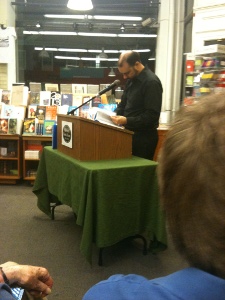 Meanwhile, back in Western Massachusetts … and specifically at
Hampshire College, the exhibit “Pulp to Pixels: Artist’s Books in the
Digital Age” is on until November 16. The exhibit is curated by Andrea
Dezsö, Steven Daiber, and Meredith Brober, is part of the “Non-Visible
and Intangible” series, and is located at the Harold F. Johnson Library.
There’s a news item about the exhibit and site with curatorial descriptions and documentation.
Meanwhile, back in Western Massachusetts … and specifically at
Hampshire College, the exhibit “Pulp to Pixels: Artist’s Books in the
Digital Age” is on until November 16. The exhibit is curated by Andrea
Dezsö, Steven Daiber, and Meredith Brober, is part of the “Non-Visible
and Intangible” series, and is located at the Harold F. Johnson Library.
There’s a news item about the exhibit and site with curatorial descriptions and documentation.
Below are photos of John Slepian, who offered his Commodore 64 for the exhibit and set it up, and a gallery visitor enjoying a 10 PRINT variant.
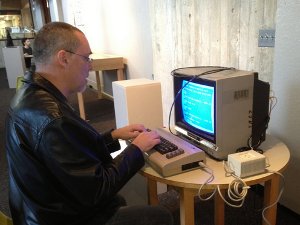
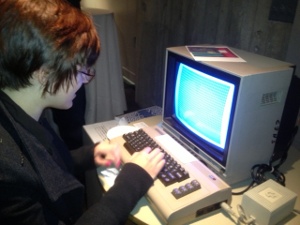
By the weekend, 10 PRINT should be available in fine online and brick-and-mortar bookstores, including my other main bookstore in Cambridge, the MIT Press Bookstore. We hope readers will enjoy the project, and that it will also be an invitation to think about collaborative research and scholarship in the humanities in a new way.



Below are photos of John Slepian, who offered his Commodore 64 for the exhibit and set it up, and a gallery visitor enjoying a 10 PRINT variant.


By the weekend, 10 PRINT should be available in fine online and brick-and-mortar bookstores, including my other main bookstore in Cambridge, the MIT Press Bookstore. We hope readers will enjoy the project, and that it will also be an invitation to think about collaborative research and scholarship in the humanities in a new way.
HuffPo’s Interview with NiMo
Illya Szilak interviews Nick Montfort
in the article “The Death of the Novel: How E-Lit Revolutionizes
Fiction,” the first of a series of posts on electronic literature.
Tracy Fullerton this Thursday at MIT on “Walden, a game”
Tried of thinking about well-defined regions of red and blue?
… start thinking about PURPLE BLURB, the digital writing series at MIT.
We’ll have our next event with TRACY FULLERTON, an experimental game designer, professor and director of the Game Innovation Lab at the USC School of Cinematic Arts where she holds the Electronic Arts Endowed Chair in Interactive Entertainment. The Game Innovation Lab is a design research center that has produced several influential independent games, including Cloud, flOw, Darfur is Dying, The Misadventures of P.B. Winterbottom, and The Night Journey – a collaboration with media artist Bill Viola. Tracy is also the author of Game Design Workshop: A Playcentric Approach to Creating Innovative Games, a design textbook in use at game programs worldwide.
Fullerton’s talk “Finer Fruits: Experiment in Life and Play at Walden” will take place:
November 8
5:30pm
In MIT’s 32-155 (Stata Center)
This is a joint event with the CMS Colloquium, and supported by the Angus N. MacDonald fund.
Walden, a game, is an experiment in play being made about an experiment in living. The game simulates Henry David Thoreau’s experiment in living a simplified existence as articulated in his book Walden. It puts Thoreau’s ideas about the essentials of life into a playable form, in which players can take on the role of Thoreau, attending to the “meaner” tasks of life at the Pond – providing themselves with food, fuel, shelter and clothing – while trying not to lose sight of their relationship to nature, where the Thoreau found the true rewards of his experiment, his “finer fruits” of life. The game is a work in progress, and this talk will look closely at the design of the underlying system and the cycles of thought that have gone into developing it. It will also detail the creation of the game world, which is based on close readings of Thoreau’s work, and the projected path forward for the team as we continue our sojourn in experimental in play.
We have also added a Purple Blurb event this semester. Prof. Al Filreis of the University of Pennsylvania Kelly Writers House will join us for a conversation with Nick Montfort on December 10 at 5:30pm in 6-120. He’ll discuss his experience teaching modern poetry to 34,000 students online. More about this as the time nears …
For now, I hope to see you this Thursday for Tracy Fullerton’s presentation about Walden, a game.
… start thinking about PURPLE BLURB, the digital writing series at MIT.
We’ll have our next event with TRACY FULLERTON, an experimental game designer, professor and director of the Game Innovation Lab at the USC School of Cinematic Arts where she holds the Electronic Arts Endowed Chair in Interactive Entertainment. The Game Innovation Lab is a design research center that has produced several influential independent games, including Cloud, flOw, Darfur is Dying, The Misadventures of P.B. Winterbottom, and The Night Journey – a collaboration with media artist Bill Viola. Tracy is also the author of Game Design Workshop: A Playcentric Approach to Creating Innovative Games, a design textbook in use at game programs worldwide.
Fullerton’s talk “Finer Fruits: Experiment in Life and Play at Walden” will take place:
November 8
5:30pm
In MIT’s 32-155 (Stata Center)
This is a joint event with the CMS Colloquium, and supported by the Angus N. MacDonald fund.
Walden, a game, is an experiment in play being made about an experiment in living. The game simulates Henry David Thoreau’s experiment in living a simplified existence as articulated in his book Walden. It puts Thoreau’s ideas about the essentials of life into a playable form, in which players can take on the role of Thoreau, attending to the “meaner” tasks of life at the Pond – providing themselves with food, fuel, shelter and clothing – while trying not to lose sight of their relationship to nature, where the Thoreau found the true rewards of his experiment, his “finer fruits” of life. The game is a work in progress, and this talk will look closely at the design of the underlying system and the cycles of thought that have gone into developing it. It will also detail the creation of the game world, which is based on close readings of Thoreau’s work, and the projected path forward for the team as we continue our sojourn in experimental in play.
We have also added a Purple Blurb event this semester. Prof. Al Filreis of the University of Pennsylvania Kelly Writers House will join us for a conversation with Nick Montfort on December 10 at 5:30pm in 6-120. He’ll discuss his experience teaching modern poetry to 34,000 students online. More about this as the time nears …
For now, I hope to see you this Thursday for Tracy Fullerton’s presentation about Walden, a game.
Two E-Lit Gatherings in Europe
I was at a workshop in Bergen on Tuesday and a conference in Edinburgh Thursday through Saturday. There were many interesting things to report or at least mention, and I’ve only managed to note two of them on the blog so far. I’ll also mention that in Bergen, I did the first transverse reading of the full ppg256 series,
reading through the seven generators’ output four times. I was very
pleased with the art gallery setting, the other readings and screenings,
and the way my reading went.
Fortunately there is good documentation of both events in the ELMCIP Knowledge Base, a resource that lists critical work, events, and presentations about electronic literature as well as works of e-lit themselves. For these two events, abstracts and (in the case of the “Remediating the Social” ELMCIP conference in Edinburgh) full papers are included in the Knowledge Base as well.
For instance, my presentation in Bergen, represented by an abstract in the Knowledge Base, was “The ELO and Two E-Lit Exhibits.”
And, my keynote address at the beginning of the ELMCIP conference in Edinburgh was “Programming for Fun, Together,” for which a corresponding paper is available. I covered the main topics of the paper in about the first half of the talk and spent the second half trying to explain how to program in Commodore 64 BASIC, using concrete-poem-generating programs (including 10 PRINT CHR$(205.5+RND(1)); : GOTO 10) as my examples. I began by developing a program that prints “H” or “I” at random, using bpNichol’ favorite letter (“H”) and an adjacent letter that can be seen as either a rotation of “H” or a component of it. A one-line program was developed to printing either one uniformly at random. In part, this was my response to the less interesting but certainly more conventional “HELLO WORLD” program. I continued to show how a program that printed “x” or “y” could be quickly developed by modifying this one, after using Commodore BASIC itself, via the ASC function, to determine the appropriate new ASCII code. Then, I converted that program to “our” 10 PRINT (that is, the program I and nine co-authors have written a book about) and showed how the distribution and pair of characters could be changed.
In presenting these various 10 PRINT programs and developing new ones through modification, I wanted to show that BASIC programming can truly be undertaken in an exploratory way without a great deal of background. I also wanted to share with the group some of the amazing facility for poetic experimentation that is provided by a 30-year-old computer, inexpensive even at the time, that allows you to program immediately after being turned on.
Jill Walker Rettberg liveblogged my keynote (bringing back another wonderful historical tradition in digital media!) and there was also some discussion of the talk on Twitter.
My only regret related to the talk was that Rita Raley, who was scheduled to be the respondent for my talk, was unable to make it to the conference due to the storm damage and flooding in New York City. Scott Rettberg filled in and made a worthwhile connection from collaborative, social programming activity to collaborative writing, also questioning my four points about programming socially for fun.
The Edinburgh conference, which featured an exhibit at the Inspace gallery and performances throughout, resulted in a book that includes not only academic papers but also “artist’s pages” documenting the artistic works. I hope you’ll be interested in taking a look at the good supply of online “Remediating the Social” material.
Fortunately there is good documentation of both events in the ELMCIP Knowledge Base, a resource that lists critical work, events, and presentations about electronic literature as well as works of e-lit themselves. For these two events, abstracts and (in the case of the “Remediating the Social” ELMCIP conference in Edinburgh) full papers are included in the Knowledge Base as well.
For instance, my presentation in Bergen, represented by an abstract in the Knowledge Base, was “The ELO and Two E-Lit Exhibits.”
And, my keynote address at the beginning of the ELMCIP conference in Edinburgh was “Programming for Fun, Together,” for which a corresponding paper is available. I covered the main topics of the paper in about the first half of the talk and spent the second half trying to explain how to program in Commodore 64 BASIC, using concrete-poem-generating programs (including 10 PRINT CHR$(205.5+RND(1)); : GOTO 10) as my examples. I began by developing a program that prints “H” or “I” at random, using bpNichol’ favorite letter (“H”) and an adjacent letter that can be seen as either a rotation of “H” or a component of it. A one-line program was developed to printing either one uniformly at random. In part, this was my response to the less interesting but certainly more conventional “HELLO WORLD” program. I continued to show how a program that printed “x” or “y” could be quickly developed by modifying this one, after using Commodore BASIC itself, via the ASC function, to determine the appropriate new ASCII code. Then, I converted that program to “our” 10 PRINT (that is, the program I and nine co-authors have written a book about) and showed how the distribution and pair of characters could be changed.
In presenting these various 10 PRINT programs and developing new ones through modification, I wanted to show that BASIC programming can truly be undertaken in an exploratory way without a great deal of background. I also wanted to share with the group some of the amazing facility for poetic experimentation that is provided by a 30-year-old computer, inexpensive even at the time, that allows you to program immediately after being turned on.
Jill Walker Rettberg liveblogged my keynote (bringing back another wonderful historical tradition in digital media!) and there was also some discussion of the talk on Twitter.
My only regret related to the talk was that Rita Raley, who was scheduled to be the respondent for my talk, was unable to make it to the conference due to the storm damage and flooding in New York City. Scott Rettberg filled in and made a worthwhile connection from collaborative, social programming activity to collaborative writing, also questioning my four points about programming socially for fun.
The Edinburgh conference, which featured an exhibit at the Inspace gallery and performances throughout, resulted in a book that includes not only academic papers but also “artist’s pages” documenting the artistic works. I hope you’ll be interested in taking a look at the good supply of online “Remediating the Social” material.
The Cut Version, with Ads
Jason Huff and Mimi Cabell did an excellent conceptual writing project, just presented at ELMCIP in Edinburgh.


A Study of the IF Community
Here at the ELMCIP “Remediating the Social” conference, literature professor Yra van Dijk was added to the program and presented, today, on a topic of special interest to me – the interactive fiction community.
She has been examining the 2001-2004 exchanges on the IF newsgroups (rec.arts.int-fiction and rec.games.int-fiction) with a focus on the online exchanges and the community’s archiving of them. Self-reflexivity and longevity makes this community particularly interesting to her. She sees a blending of roles: Practicioners, reviewers, and consumers are different roles but not different people. Her study uses literary sociology and literary theory, mainly Latour. She mentioned the “Interesting discussions” available on the Wiki; one does not have to join a mailing list to read them.
Technical issues, theory and self-reflection are discussed – many things that would be taken up by institutions in other contexts. She noted that actors on the newsgroups do not behave as if anonymous, but behave as they might in person. She noted as well that some in-person meetups now happen, that people often reflect on how to raise the profile of IF, and that awards and prizes imitate hierarchies of print literature, play a part in canonizing and archiving. She studied the consideration of IF as art – and found that most of the discussion is about craftsmanship, not poetics. Exchanges of code happen, and people discussed questions about how to write, not what we write.
She found that a well-defined genre is being redefined through discussion. Taste is being developed and discussed; intelligent readership is supported. An archive of knowledge about these works has been produced, along with an institutional network. So, the seemingly peripheral IF community has many interesting things happening. It resembles (to her surprise, she said) the 19th century literary communities with their emphasis on craftsmanship and criticism.
I regret that I didn’t get to speak with van Dijk, but it was great to hear her discussion of the IF community … and I have now something to report on at the next People’s Republic of Interactive Fiction meeting.
She has been examining the 2001-2004 exchanges on the IF newsgroups (rec.arts.int-fiction and rec.games.int-fiction) with a focus on the online exchanges and the community’s archiving of them. Self-reflexivity and longevity makes this community particularly interesting to her. She sees a blending of roles: Practicioners, reviewers, and consumers are different roles but not different people. Her study uses literary sociology and literary theory, mainly Latour. She mentioned the “Interesting discussions” available on the Wiki; one does not have to join a mailing list to read them.
Technical issues, theory and self-reflection are discussed – many things that would be taken up by institutions in other contexts. She noted that actors on the newsgroups do not behave as if anonymous, but behave as they might in person. She noted as well that some in-person meetups now happen, that people often reflect on how to raise the profile of IF, and that awards and prizes imitate hierarchies of print literature, play a part in canonizing and archiving. She studied the consideration of IF as art – and found that most of the discussion is about craftsmanship, not poetics. Exchanges of code happen, and people discussed questions about how to write, not what we write.
She found that a well-defined genre is being redefined through discussion. Taste is being developed and discussed; intelligent readership is supported. An archive of knowledge about these works has been produced, along with an institutional network. So, the seemingly peripheral IF community has many interesting things happening. It resembles (to her surprise, she said) the 19th century literary communities with their emphasis on craftsmanship and criticism.
I regret that I didn’t get to speak with van Dijk, but it was great to hear her discussion of the IF community … and I have now something to report on at the next People’s Republic of Interactive Fiction meeting.
50 Years of the MIT Press
Congratulations to the MIT Press on 50 years, and on their new website.
The new site includes a new and improved system for ordering books directly from the press. If you want to try it out, allow me to recommend Twisty Little Passages, The New Media Reader, Racing the Beam, and/or the forthcoming (in just a few weeks) 10 PRINT CHR$(205.5+RND(1)); : GOTO 10.
The new site includes a new and improved system for ordering books directly from the press. If you want to try it out, allow me to recommend Twisty Little Passages, The New Media Reader, Racing the Beam, and/or the forthcoming (in just a few weeks) 10 PRINT CHR$(205.5+RND(1)); : GOTO 10.
10 PRINT Reading / Release Party
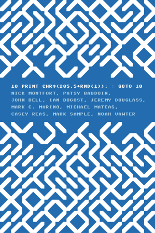
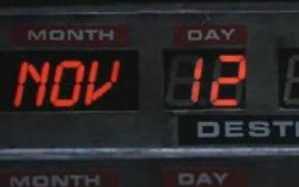
Our first event for 10 PRINT is scheduled for:
Monday
November 12, 2012
7pm
at the
Harvard Book Store
1256 Massachusetts Ave.
Cambridge, MA.
This means, of course, that the book will be printed and available for sale by then, which is less than a month from now.
The Harvard Book Store is an independent book store in Harvard Square, founded in 1932.
Of the ten authors of 10 PRINT, we’re planning to have at least me (Nick Montfort), Patsy Baudoin, and Noah Vawter there for some reading from the book, comments on the titular program and the writing of the book, and discussion. The reading is free and takes place at the bookstore itself, as the page on the event explains.
Queerskins and The Silent History Are New Digital Novels
I discuss the history and context of electronic literature in this article about the new digital novel The Silent History. The article, by Eugenia Williamson, appears in Saturday’s print edition of the Boston Globe.
The Silent History certainly looks like a compelling project.
Another just-released digital novel which is also quite compelling, although it doesn’t have the same PR apparatus behind it, is Queerskins by Illya Szilak, designed by Cyril Tsiboulski. Although I’ve not read a great deal of this new novel yet, I’m impressed by its multimedia and literary engagement with a difficult aspect of recent American experience.
The Silent History certainly looks like a compelling project.
Another just-released digital novel which is also quite compelling, although it doesn’t have the same PR apparatus behind it, is Queerskins by Illya Szilak, designed by Cyril Tsiboulski. Although I’ve not read a great deal of this new novel yet, I’m impressed by its multimedia and literary engagement with a difficult aspect of recent American experience.
Queerskins explores the nature of love and justice through the story of a young gay physician from a rural Midwestern Catholic family who dies of AIDS at the start of the epidemic. Queerskins’ interface consists of layers of sound, text, and image that users can navigate at random or experience as a series of multimedia collages. Images of the mythic and the everyday, the sacred and the profane, from banal vacation footage to vintage burlesque, interact rhizomatically with text and audio monologues to subvert preconceived notions of gender, sexuality, and morality.Queerskins can be read online for free, and it can be reading using free software; an iPad is not required. Although I’m a fan of location-based and other innovation and respect those working on all sorts of platforms, what I’d like for the future of literature is for it to be like this – fully accessible on even a public library computer and Internet-connected laptops throughout the world.
Debate Debate
Governor Romney said that was a tragic mistake; we should have left
Governor Romney said that was a tragic mistake; we should have left
I —
I —
period.
period.
are you —
are you —
in — in —
in — in —
no,
no,
I’ll tell you what’s worse.
I’ll tell you what’s worse.
I — I —
I — I —
we —
we —
went —
went —
more —
more —
no —
no —
all —
all —
We are not going to run away —
We are not going to run away —
I do.
I do.
you —
you —
Step up.
Step up.
Let —
Let —
It’s —
It’s —
I —
I —
— my
— my
let —
let —
Governor Romney said that was a tragic mistake; we should have left
I —
I —
period.
period.
are you —
are you —
in — in —
in — in —
no,
no,
I’ll tell you what’s worse.
I’ll tell you what’s worse.
I — I —
I — I —
we —
we —
went —
went —
more —
more —
no —
no —
all —
all —
We are not going to run away —
We are not going to run away —
I do.
I do.
you —
you —
Step up.
Step up.
Let —
Let —
It’s —
It’s —
I —
I —
— my
— my
let —
let —
Purple Blurb at MIT this semester!
Yes we have Purple Blurb! The first event is in less than a week – sorry for the short notice; I hope you locals can join us. Here are the details:
Tracy Fullerton, M.F.A., is an experimental game designer, professor and director of the Game Innovation Lab at the USC School of Cinematic Arts where she holds the Electronic Arts Endowed Chair in Interactive Entertainment. The Game Innovation Lab is a design research center that has produced several influential independent games, including Cloud, flOw, Darfur is Dying, The Misadventures of P.B. Winterbottom, and The Night Journey – a collaboration with media artist Bill Viola. Tracy is also the author of Game Design Workshop: A Playcentric Approach to Creating Innovative Games, a design textbook in use at game programs worldwide.
As always, all events are free and open to the public. The Purple Blurb series is supported by the Angus N. MacDonald fund and Comparative Media Studies / Writing and Humanistic Studies.
Monday October 1, 5:30pm in 6-120
Rafael Pérez y Pérez, Fox Harrell, and Nick Montfort
In conversation about narrative generation and MEXICA, GRIOT, and Curveship
Three creators of poetic and imaginative systems speak about computational creativity, narrative generation, and the way systems for this sort of work are culturally generated. Rafael Pérez y Pérez is creator of the plot-focused MEXICA system for the generation of stories and is Profesor/Investigador Titular C in the Departamento de Tecnologías de la Información at the Universidad Autónoma Metropolitana, Unidad Cuajimalpa, México D. F. Fox Harrell is creator of GRIOT and the Alloy algorithm, which generates literary and multimedia texts based on conceptual structures. Harrell is associate professor of digital media at MIT in CMS/WHS, a principal investigator at CSAIL, and head of the Imagination, Computation, and Expression Laboratory. Nick Montfort developed Curveship, an interactive fiction and text generation systems that allows for parametrically controlled narrative variation. Montfort is associate professor of digital media at MIT in CMS/WHS and head of the Trope Tank.Thursday November 8, 5:30pm in 32-155
Tracy Fullerton
“Finer Fruits: Experiment in Life and Play at Walden”
A joint event with the CMS Colloquium
Walden, a game, is an experiment in play being made about an experiment in living. The game simulates Henry David Thoreau’s experiment in living a simplified existence as articulated in his book Walden. It puts Thoreau’s ideas about the essentials of life into a playable form, in which players can take on the role of Thoreau, attending to the “meaner” tasks of life at the Pond – providing themselves with food, fuel, shelter and clothing – while trying not to lose sight of their relationship to nature, where the Thoreau found the true rewards of his experiment, his “finer fruits” of life. The game is a work in progress, and this talk will look closely at the design of the underlying system and the cycles of thought that have gone into developing it. It will also detail the creation of the game world, which is based on close readings of Thoreau’s work, and the projected path forward for the team as we continue our sojourn in experimental in play.Tracy Fullerton, M.F.A., is an experimental game designer, professor and director of the Game Innovation Lab at the USC School of Cinematic Arts where she holds the Electronic Arts Endowed Chair in Interactive Entertainment. The Game Innovation Lab is a design research center that has produced several influential independent games, including Cloud, flOw, Darfur is Dying, The Misadventures of P.B. Winterbottom, and The Night Journey – a collaboration with media artist Bill Viola. Tracy is also the author of Game Design Workshop: A Playcentric Approach to Creating Innovative Games, a design textbook in use at game programs worldwide.
As always, all events are free and open to the public. The Purple Blurb series is supported by the Angus N. MacDonald fund and Comparative Media Studies / Writing and Humanistic Studies.
Christmas Bytes Seeks Funds for Filming
As filmmaker Brett Neveu explains in his video about Christmas Bytes,
he’s aiming to make the resonant Christmas movie for our (or at least
my) generation, when the coveted item was not an official Red Ryder,
carbine action, two-hundred shot range model air rifle, but rather the
Atari Video Computer System.
Ian Bogost and I donated a signed copy of Racing the Beam to the campaign, and there are a raft of other 80s-related enticements. For instance, I tend the judge the wisdom of my actions by whether anonymous San Francisco band The Residents are doing the same, and in this case, I am pleased to say that they also have contributed CDs — and are lined up to do the original soundtrack for the film.
Until tomorrow you can also vote for Christmas Bytes as the movie of the week on Indiewire.
Games by the Book
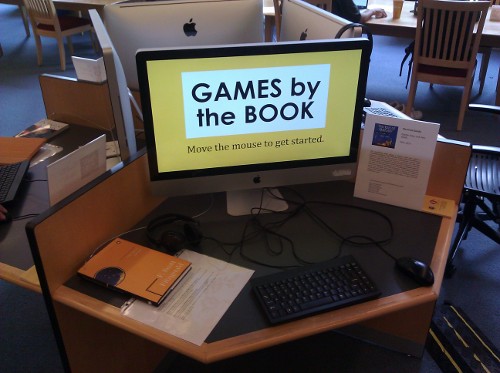
The Hayden Library (in MIT’s Building 14) is hosting an interactive exhibition starting on September 7th. Visitors to the second floor will be able to play four videogames that are adapted from literary works, from Sophocles and Shakespeare to F. Scott Fitzgerald and Douglas Adams. The exhibit explores the range of approaches taken to create video games of literary works, The result is often whimsical, turning the worlds of these stories into spaces to be explored, often transforming them according video game conventions.
The games featured in the exhibit invite players to become Nick Carraway, the narrator of The Great Gatsby, dodging drunken partygoers in his way to meet Gatsby; explore the world of Shakespeare’s plays; carry out an exercise of introspection based on Sophocles’ Oedipus at Colonus; or revisit the events of The Hitchhiker’s Guide to the Galaxy.
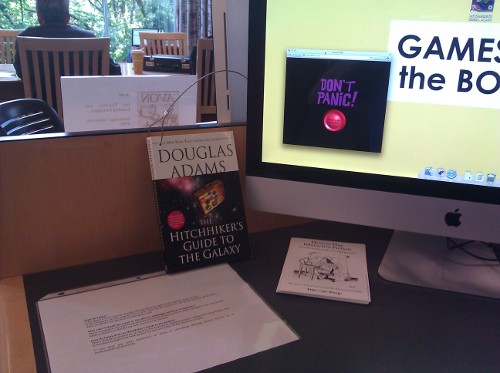
Games by the Book, curated by Clara Fernández-Vara and Nick Montfort, will be open to the public until October 8th, in the Humanities library, on the 2nd floor of the Hayden Library. Further details can be found at:
http://trope-tank.mit.edu/games_by_the_book/
The exhibit is sponsored by the De Florez Fund for Humor, the MIT Council of the Arts, the MIT Game Lab, the Electronic Literature Organization, and Comparative Media Studies.
www.badlandsunlimited.com/ :
Available now exclusively on Apple iBooks
HELL_TREE by Petra CortrightE-book, 107 pages
Available now on Apple iBooks and Amazon
The Help, A Companion Guideby Rachel HarrisonE-book, 131 pages
Available now on Apple iBooks and Amazon
www.badlandsunlimited.com
Badlands Unlimited is pleased to announce three new titles for the summer.
How To Download A BoyfriendInteractive e-book, 57 pages, 2012
ISBN 978-1-936440-33-7
Available now exclusively on Apple iBooks
The first of its kind, How To Download a Boyfriend is a group exhibition in the form of an interactive e-book. Featuring the work of 50 artists from New York and elsewhere, HTDAB showcases what is being made at the intersection of digital and popular culture today. Artists and writers have also created interactive “quizzes” that test readers with funny, probing, or simply absurd questions about love and longing in the 21st century. Curated by the staff of Badlands Unlimited.
AA Bronson and Ryan Brewer ◐ Alan Schaffer ❏ A.E. Benenson ☂ Ann Hirsch ☯ Antoine Catala and Margaret Lee ✪ Arend DeGruyter-Helfer ☻ Ben Schumacher ✌ Billy Rennekamp ▲ Brenna Murphy ❥ Calla Henkel and Max Pitegoff ✿ Cara Benedetto ▨ Chris Collins ☮ Christian de Vietri ☻ Clayton Deutsch ø Cory Arcangel ⚑ Dani Leventhal ✞ Daniel Chew ✦ Daniel Leyva ✰ David OReilly ✺ Ei Arakawa ☂ Elliott Wright ☀ Georgia Sagri ▣ Hayley Silverman ☯ Ian Cheng ✿ Jaakko Pallasvuo ▣ Josh Kline ▼ Katja Novitskova ❀ Kyunghee Jwa ✰ Martine Syms ✜ Matthew Raviotta ✌ Meghan Radju ✦ Micaela Durand ◐ Michelle Ceja ✰ Nick DeMarco ⚑ Paul Chan Δ Peggy Ahwesh ✰ Petra Cortright ✖ Rachel Rose ▣ Sam Pulitzer ✺ Sarah Chow ø Scott Keightley ✞ Timur Si Qin △ Thomas Bayrle ✤ Tony Conrad ✪ Travess Smalley ☀ Travis Hallenbeck ╰☆╮Veronica So
HELL_TREE by Petra CortrightE-book, 107 pages, 2012
ISBN 978-1-936440-37-5
Available now on Apple iBooks and Amazon
HELL_TREE is the first e-book by acclaimed net artist Petra Cortright. Since 2005, Cortright has produced a unique body of work that evokes the precarious nature of life in the age of media saturation. HELL_TREE consists of a series of writings by Cortright that exists solely within the context of her computer desktop. By turns technical, absurd, tender, and urgent, HELL_TREE is an unfiltered recording of Cortright’s thoughts during the course of her days. To-do lists conflate with poems. Motivational pronouncements interlace with inflammatory tweets. Texts and images pile and compile without any particular structure other than an unspoken directive to keep everything moving and formless. HELL_TREE embodies this spirit of formlessness. It is an intimate portrait of the artist as a young medium.
The Help, A Companion Guideby Rachel HarrisonE-book, 131 pages, 2012
ISBN: 978-1-936440-38-2
Available now on Apple iBooks and Amazon
The Help, A Companion Guide is based on images surrounding Harrison’s 2012 solo show at Greene Naftali Gallery entitled The Help. The exhibition shares its title with Harrison’s photograph of the back door maintenance entrance to Duchamp’s Étant donnés, which is visible in the exhibition galleries of the Philadelphia Museum of Art, and alludes to the entangled roles of the Artist, the Muse, and the Help. The Help, A Companion Guide showcases visual and conceptual elements that Harrison used in the making of The Help: from early Google image searches and reference materials, to documentation of the installation process and its attendant “help,” to selected details of the final sculptural works. Harrison creates visual and temporal rhymes that playfully link her finished sculptural works to a constellation of materials and
services that express the immanent sociality at stake in every work of art.
About Badlands UnlimitedFounded by Paul Chan in 2010, Badlands Unlimited publishes e-books, limited edition paper books, and artist works in digital and print forms. Historical distinctions between books, files, and artworks are dissolving rapidly. We publish and produce new works by artists and writers that embody the spirit of this emerging dissolution. We make books in an expanded field.

Ian Bogost and I donated a signed copy of Racing the Beam to the campaign, and there are a raft of other 80s-related enticements. For instance, I tend the judge the wisdom of my actions by whether anonymous San Francisco band The Residents are doing the same, and in this case, I am pleased to say that they also have contributed CDs — and are lined up to do the original soundtrack for the film.
Until tomorrow you can also vote for Christmas Bytes as the movie of the week on Indiewire.
T-CIAIG (Computational Narrative & Games) Due October 5
The tickets are now diamonds!
Ian Horswill, Michael Young and I are editing a special issue of IEEE Transactions on Computational Intelligence and AI in Games (T-CIAIG), and your submissions are invited — until October 5, 2011. We have extended the deadline two weeks.
Specifically:
Ian Horswill, Michael Young and I are editing a special issue of IEEE Transactions on Computational Intelligence and AI in Games (T-CIAIG), and your submissions are invited — until October 5, 2011. We have extended the deadline two weeks.
Specifically:
The T-CIAIG Special Issue on Computational Narrative and Games solicits papers on all topics related to narrative in computational media and of relevance to games, including but not limited to:I posted the full call here way back in February: “Call for papers: Special Issue on Computational Narrative and Games.” We are very interested in submissions dealing with computationally involved work on the important topic of narrative.
- Storytelling systems
- Story generation
- Drama management
- Interactive fiction
- Story presentation, including performance, lighting, staging, music and camera control
- Dialog generation
- Authoring tools
- Human-subject evaluations of systems
Friday’s the Deadline: Special Issue on Computational Narrative and Games
As mentioned here before, Ian Horswill, Michael Young and I are
editing a special issue of IEEE Transactions on Computational
Intelligence and AI in Games (T-CIAIG), and your submissions are
invited. Specifically:
All author/submission info is online. Submission is done through Manuscript Central.
Let me know (soon!) in comments or by email if you have questions.
The T-CIAIG Special Issue on Computational Narrative and Games solicits papers on all topics related to narrative in computational media and of relevance to games, including but not limited to:I posted the full call here way back in February: “Call for papers: Special Issue on Computational Narrative and Games.” So it seems appropriate to remind everyone now, as the deadline for submissions is this Friday, September 21, 2012.
- Storytelling systems
- Story generation
- Drama management
- Interactive fiction
- Story presentation, including performance, lighting, staging, music and camera control
- Dialog generation
- Authoring tools
- Human-subject evaluations of systems
All author/submission info is online. Submission is done through Manuscript Central.
Let me know (soon!) in comments or by email if you have questions.
Games by the Book, an Exhibit
Games by the Book
Videogame Adaptations of Literary Works in the Hayden Library

The Hayden Library (in MIT’s Building 14) is hosting an interactive exhibition starting on September 7th. Visitors to the second floor will be able to play four videogames that are adapted from literary works, from Sophocles and Shakespeare to F. Scott Fitzgerald and Douglas Adams. The exhibit explores the range of approaches taken to create video games of literary works, The result is often whimsical, turning the worlds of these stories into spaces to be explored, often transforming them according video game conventions.
The games featured in the exhibit invite players to become Nick Carraway, the narrator of The Great Gatsby, dodging drunken partygoers in his way to meet Gatsby; explore the world of Shakespeare’s plays; carry out an exercise of introspection based on Sophocles’ Oedipus at Colonus; or revisit the events of The Hitchhiker’s Guide to the Galaxy.

Games by the Book, curated by Clara Fernández-Vara and Nick Montfort, will be open to the public until October 8th, in the Humanities library, on the 2nd floor of the Hayden Library. Further details can be found at:
http://trope-tank.mit.edu/games_by_the_book/
The exhibit is sponsored by the De Florez Fund for Humor, the MIT Council of the Arts, the MIT Game Lab, the Electronic Literature Organization, and Comparative Media Studies.
An Aphorism
Lady Gaga is the larval stage of Yo-Landi Vi$$er. The previous, embryonic stage: Katy Perry.
A New Book: Implementation
Implementation has stuck, and it’s now bound as a book.
It’s a beautifully designed full-color hardback that documents this
project about the war on terror, allowing the reader to view photographs
showing where the novel manifested itself while also reading the entire
text of the novel.
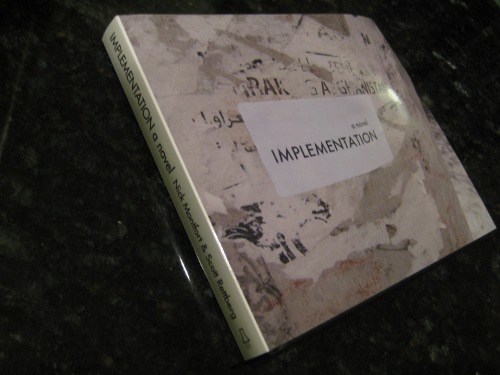
In 2003, when Scott Rettberg and I were fairly close by (he was near Atlantic City, I lived in Philadelphia), we decided to write a rather atypical novel together. We collaborated from concept through proofreading, and beyond that stage, to write eight installments of three sheets each, with ten shorts texts on each sheet. The texts we wrote were, in 2004, printed on stickers – shipping labels – and adhered to public surfaces around the world by the two of us and by other participants in the project. Initially, we mailed each installment to a group of people without consulting them beforehand. Then, we made the sheets available as PDFs on the Web so that anyone could download them and print them out on label paper. Some of the placements of Implementation stickers were documented in photographs, and eventually more than 1600 of these wound up on our Implementation site.
As Scott has noted on the page for the book,
Some of the other aspects of the project were divided up. I wrote and ran scripts to assemble new Web pages and maintained the site; Scott did the photo processing and was certainly the more avid photographer. (I didn’t even have a digital camera in 2004.) I contributed to the making of the book on a few occasions, but this latest Implementation manifestation is thanks to Scott’s work. He secured funding from Arts Council Norway (the arts organization of his new home) and enlisted the designer Adam Richer. He also organized a new deployment and documentation of the novel in 2009-2010. If we had only the photos from 2004, a book like this wouldn’t have been possible. We encouraged people to send us pre-processed, low-resolution photos that were ready for the Web. The photos in the book are quite different. They are very suitable for print and for both reading and viewing.
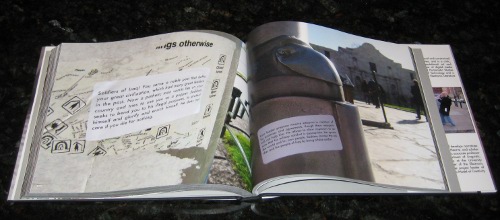
Implementation is really quite highly slick and quite highly punk. On the slick side, in one photo included in the book, Harry Mathews (who placed some Implementation stickers) stares at an Implementation sticker we have placed on a wine bottle. Not represented in the book is that on July 18, 2004, Scott and I were stopped by three police officers outside Penn Station for photographing an Implementation sticker which was, as we learned, on a bomb-proof trash can. One of the offers ran a warrant check on Scott as we waited.
I’m pleased with the project in terms of the novel’s text, which juxtaposes the everyday experience of Middle America with that of African-American soldiers deployed in Iraq. The novel moves from the absurd (Scott’s never going to forgive me for the pirates) to the ordinary, intersecting both rather often in a way that still seems authentic and effective.
Implementation is also very pleasing to me because of how that text was created – collaboratively – and how it was originally shared – by mail, by PDF download, through photos on a Web site, in public spaces. Now, I’m delighted at how the book turned out, thanks to Scott’s work, and how it represents the particapatory sharing of the novel.
The book is not cheap, but it’s an high-quality photography book and a novel packed into one. (It’s also being offered at cost, so only the publisher is making anything off of it.) For the street, and for the screen, you can still visit the Implementation site to view photos and download PDFs. For browsing on the coffee table, and for reading Implementation like the novel it is, I do suggest the book.

In 2003, when Scott Rettberg and I were fairly close by (he was near Atlantic City, I lived in Philadelphia), we decided to write a rather atypical novel together. We collaborated from concept through proofreading, and beyond that stage, to write eight installments of three sheets each, with ten shorts texts on each sheet. The texts we wrote were, in 2004, printed on stickers – shipping labels – and adhered to public surfaces around the world by the two of us and by other participants in the project. Initially, we mailed each installment to a group of people without consulting them beforehand. Then, we made the sheets available as PDFs on the Web so that anyone could download them and print them out on label paper. Some of the placements of Implementation stickers were documented in photographs, and eventually more than 1600 of these wound up on our Implementation site.
As Scott has noted on the page for the book,
Implementation is about four main characters: Frank, Samantha, Kilroy, and Roxanne, who live in a Midwestern town. The action of the novel begins in September 2001 and runs through the beginning of Operation Iraqi Freedom in 2003. One of the characters, Kilroy, is a reservist who is called up and then sent to Iraq, but the other characters are affected in much more oblique ways by the attack on the World Trade Center and the changes that follow. They continue to dine at restaurants, drink at bars, work, worry about their jobs and careers, have flings and relationships, and go to celebrations and funerals. While even a bombing in town changes little on the surface of these lives, the effects of the war can be read in shifts in their gestures, longings, and language. Implementation is a novel about the peripheral, everyday, psychological toll of the war on terror.The writing of Implementation was done coequally. We thought up the idea together and drafted many of the texts on index cards in bars, revised some of them the same way and some by email, and worked through the emplotment, the characters, the dialogues, and essentially all aspects of the novel together.
Some of the other aspects of the project were divided up. I wrote and ran scripts to assemble new Web pages and maintained the site; Scott did the photo processing and was certainly the more avid photographer. (I didn’t even have a digital camera in 2004.) I contributed to the making of the book on a few occasions, but this latest Implementation manifestation is thanks to Scott’s work. He secured funding from Arts Council Norway (the arts organization of his new home) and enlisted the designer Adam Richer. He also organized a new deployment and documentation of the novel in 2009-2010. If we had only the photos from 2004, a book like this wouldn’t have been possible. We encouraged people to send us pre-processed, low-resolution photos that were ready for the Web. The photos in the book are quite different. They are very suitable for print and for both reading and viewing.

Implementation is really quite highly slick and quite highly punk. On the slick side, in one photo included in the book, Harry Mathews (who placed some Implementation stickers) stares at an Implementation sticker we have placed on a wine bottle. Not represented in the book is that on July 18, 2004, Scott and I were stopped by three police officers outside Penn Station for photographing an Implementation sticker which was, as we learned, on a bomb-proof trash can. One of the offers ran a warrant check on Scott as we waited.
I’m pleased with the project in terms of the novel’s text, which juxtaposes the everyday experience of Middle America with that of African-American soldiers deployed in Iraq. The novel moves from the absurd (Scott’s never going to forgive me for the pirates) to the ordinary, intersecting both rather often in a way that still seems authentic and effective.
Implementation is also very pleasing to me because of how that text was created – collaboratively – and how it was originally shared – by mail, by PDF download, through photos on a Web site, in public spaces. Now, I’m delighted at how the book turned out, thanks to Scott’s work, and how it represents the particapatory sharing of the novel.
The book is not cheap, but it’s an high-quality photography book and a novel packed into one. (It’s also being offered at cost, so only the publisher is making anything off of it.) For the street, and for the screen, you can still visit the Implementation site to view photos and download PDFs. For browsing on the coffee table, and for reading Implementation like the novel it is, I do suggest the book.
A Rough-Cut Gorge
“Rough Cuts: Media and Design in Process,”
a set of “middle-state artifacts” curated by Kari Kraus, has just been
presented as part of The New Everyday, a project at MediaCommons.
My contribution is a printout of “Taroko Gorge” in the originalKlingon
Python. I also offer some discussion of this printed page, representing
one phase of a poetry generator that has been reworked and plundered
more than a dozen times.
My contribution is a printout of “Taroko Gorge” in the original
Shuffle Literature? Read ‘Em and Weep
Among several notable new articles in ebr (electronic book review), please find “Shuffle Literature and the Hand of Fate” by Zuzana Husárová and Nick Montfort:

Zuzana Husárová and Nick Montfort up the ante for experimental writing by examining the category of “shuffle literature.” What is shuffle literature? Simply put: books that are meant to be shuffled. Using formal reading of narrative and themes, but also a material reading of construction and production, Husárová and Montfort show that there are many writing practices and readerly strategies associated with this diverse category of literature.

S=A=U=S=A=G=E
Alternate (actually, rejected) titles for the famous journal L=A=N=G=U=A=G=E, recently revealed in Jacket2.
I don’t know about you, but Charles Bernstein and Bruce Andrews’s cutting room floor is often better than what ends up stuffed into my projector.
For instance, I see that Rhizome, which wound up being used, is on the list.
Maybe the next interactive fiction journal could be called Inventory.
And, I think Salad is still a great title – maybe even a better one today. It’s a dish best served cold.
I don’t know about you, but Charles Bernstein and Bruce Andrews’s cutting room floor is often better than what ends up stuffed into my projector.
For instance, I see that Rhizome, which wound up being used, is on the list.
Maybe the next interactive fiction journal could be called Inventory.
And, I think Salad is still a great title – maybe even a better one today. It’s a dish best served cold.
Civic Media from 2006
These are unedited search queries, all recorded in this sequence
and all from the same “anonymized” user, on the evening of 2006-04-07.
They were found in the user-ct-test-collection-03.txt, one of the leaked AOL search query files from 2006.
jaimiewantsahondacivic www.iwantahondacivic.com jaimiedeservessomethingthistime mickisselfish.com www.selfishhusbands.com hondacivicshondacivicshondacivics iwantahondacivic.com hondacivicforjaimie jaimiewantsahondacivicplease if you love me then please buy me a civic
A Thousand Twitters
News of a strange new social network, Monolyth, reaches us from December of this year and from Chris McDowall.
To sate the great appetites of the system, which will only publish messages at least 140,000 characters long (and will abbreviate longer ones), authors turn to unusual techniques.
One of these is generating massive texts using modified versions of Taroko Gorge, one of which is included in the blog post.
To sate the great appetites of the system, which will only publish messages at least 140,000 characters long (and will abbreviate longer ones), authors turn to unusual techniques.
One of these is generating massive texts using modified versions of Taroko Gorge, one of which is included in the blog post.
Fire Up Your Computational Narrative and Games Submissions
Ian Horswill, Michael Young and I are editing a special issue of
IEEE Transactions on Computational Intelligence and AI in Games
(T-CIAIG), and your submissions are invited. Specifically:
I recently updated the URL for author/submission info. Submission is done through Manuscript Central.
Let me know in comments or by email if you have questions.
The T-CIAIG Special Issue on Computational Narrative and Games solicits papers on all topics related to narrative in computational media and of relevance to games, including but not limited to:I posted the full call here way back in February: “Call for papers: Special Issue on Computational Narrative and Games.” So it seems appropriate to remind everyone now, as the deadline for submissions is September 21, 2012.
- Storytelling systems
- Story generation
- Drama management
- Interactive fiction
- Story presentation, including performance, lighting, staging, music and camera control
- Dialog generation
- Authoring tools
- Human-subject evaluations of systems
I recently updated the URL for author/submission info. Submission is done through Manuscript Central.
Let me know in comments or by email if you have questions.
Be Kind, Reconstruct
It’s not bigger and longer than Star Wars, but it is more uncut: “Death of the Author [Psycho Shower Scene RECON]“ by Dick Whyte. This, somewhat like the later famous Star Wars video, is a “reconstruction of Alfred Hitchcock’s famous shower scene from Psycho using amateur YouTube remakes.” 57 of them.
If you got that and you’re ready to increase the avant-garde, see also “John Cage – 4’33″ [May '68 Comeback Special RECON]“ and “Andy Warhols Eat A Hamburger [38 Scenes From YouTube RECON].” All from 2010, but recalled here for your enjoyment.
If you got that and you’re ready to increase the avant-garde, see also “John Cage – 4’33″ [May '68 Comeback Special RECON]“ and “Andy Warhols Eat A Hamburger [38 Scenes From YouTube RECON].” All from 2010, but recalled here for your enjoyment.
The Problem with “Videogames”
For years, many people have been use the word “videogames” to
describe various different things – often a similar category of games
playable in arcades and at home thanks to digital electronic technology
and using video displays. Sometimes this category is distinguished from
“computer games” which are played on general-purpose home (or, if one is
lucky, office) computers. Often people nowadays who think about gaming
don’t think of specific classic titles (Zork, Hunt the Wumpus, Star Trek) as videogames but are willing to consider them computer games.
It’s not universal to use the single-word term. The OED has only an entry for “video game” (with 1973 and 1983 references), although “videotape” is listed as a single word. In Racing the Beam, Ian Bogost and I compromised on using “videogame” as the adjective form and “video game” as the noun form, so we wrote phrases such as “videogame players” but also wrote of “popular video games.” Perhaps this was the worst of both worlds, but no one, not even our copy editor, railed at us about it.
The problem that I see is that I like to explain to people, often in writing, that I study “computer and video games.” If I use the term “videogames,” what would I say? “I study computer games and videogames”? “I study computer. Also, I study videogames”? “I study video- and computer games”?
In an effort to make videogames seem like their own special thing (which was provided to me by one editor as an explanation for why the one-word version was used), Bioshock for PC is verbally classed in an entirely different category from Bioshock for Xbox 360. Given my work as an editor of the MIT Press Platform Studies series, I certainly recognize the real importance of the subtle difference between these two – but it seems awkward as a digital media scholar to actually go and call them different things, and it seems like that is what the sleek and special term “videogame” compels us to do. Maybe I need to become retro and go back to the two-word version of the term.
It’s not universal to use the single-word term. The OED has only an entry for “video game” (with 1973 and 1983 references), although “videotape” is listed as a single word. In Racing the Beam, Ian Bogost and I compromised on using “videogame” as the adjective form and “video game” as the noun form, so we wrote phrases such as “videogame players” but also wrote of “popular video games.” Perhaps this was the worst of both worlds, but no one, not even our copy editor, railed at us about it.
The problem that I see is that I like to explain to people, often in writing, that I study “computer and video games.” If I use the term “videogames,” what would I say? “I study computer games and videogames”? “I study computer. Also, I study videogames”? “I study video- and computer games”?
In an effort to make videogames seem like their own special thing (which was provided to me by one editor as an explanation for why the one-word version was used), Bioshock for PC is verbally classed in an entirely different category from Bioshock for Xbox 360. Given my work as an editor of the MIT Press Platform Studies series, I certainly recognize the real importance of the subtle difference between these two – but it seems awkward as a digital media scholar to actually go and call them different things, and it seems like that is what the sleek and special term “videogame” compels us to do. Maybe I need to become retro and go back to the two-word version of the term.
Islands of (Text) Adventure
In the “Michelangelo” room of the Portofino Bay hotel, at Ascendio
(the latest and last in a long series of Harry Potter fan conferences),
just down the lagoon from The Islands of Adventure and the Harry Potter
area of that theme park, Flourish Klink presented her interactive
fiction, “Muggle Studies.”
(In Michelangelo the women come and go, talking of rooms…)
We had a reading/playing of the game, to start, in the People’s Republic of Interactive Fiction public reading style. It worked well; another option would have been to “demo” the game using the successful format we tried out at the New School, Penn, and some Purple Blurb IF readings. The audience was game to try commands, though, and a volunteer read the game’s text aloud.
Then, Flourish provided some context, describing a bit about IF and Inform 7.
Given the vigorousness of fandom and the way interactive fiction production continues apace, it’s particularly good to see a demonstration of and call for more crossover work.
(In Michelangelo the women come and go, talking of rooms…)
We had a reading/playing of the game, to start, in the People’s Republic of Interactive Fiction public reading style. It worked well; another option would have been to “demo” the game using the successful format we tried out at the New School, Penn, and some Purple Blurb IF readings. The audience was game to try commands, though, and a volunteer read the game’s text aloud.
Then, Flourish provided some context, describing a bit about IF and Inform 7.
Given the vigorousness of fandom and the way interactive fiction production continues apace, it’s particularly good to see a demonstration of and call for more crossover work.
Ubu Runs Ubuntu!
Welcome back to the Web’s major agglomeration of the avant-garde, Ubuweb.
(I don’t know that Ubu actually runs Ubuntu, but some statements are univocalically true regardless. And the site is back up, that’s for sure.)
(I don’t know that Ubu actually runs Ubuntu, but some statements are univocalically true regardless. And the site is back up, that’s for sure.)
www.badlandsunlimited.com/ :
How To Download A BoyfriendInteractive e-book, 57 pages
Available now exclusively on Apple iBooks
HELL_TREE by Petra CortrightE-book, 107 pages
Available now on Apple iBooks and Amazon
The Help, A Companion Guideby Rachel HarrisonE-book, 131 pages
Available now on Apple iBooks and Amazon
www.badlandsunlimited.com
How To Download A BoyfriendInteractive e-book, 57 pages, 2012
ISBN 978-1-936440-33-7
Available now exclusively on Apple iBooks
The first of its kind, How To Download a Boyfriend is a group exhibition in the form of an interactive e-book. Featuring the work of 50 artists from New York and elsewhere, HTDAB showcases what is being made at the intersection of digital and popular culture today. Artists and writers have also created interactive “quizzes” that test readers with funny, probing, or simply absurd questions about love and longing in the 21st century. Curated by the staff of Badlands Unlimited.
AA Bronson and Ryan Brewer ◐ Alan Schaffer ❏ A.E. Benenson ☂ Ann Hirsch ☯ Antoine Catala and Margaret Lee ✪ Arend DeGruyter-Helfer ☻ Ben Schumacher ✌ Billy Rennekamp ▲ Brenna Murphy ❥ Calla Henkel and Max Pitegoff ✿ Cara Benedetto ▨ Chris Collins ☮ Christian de Vietri ☻ Clayton Deutsch ø Cory Arcangel ⚑ Dani Leventhal ✞ Daniel Chew ✦ Daniel Leyva ✰ David OReilly ✺ Ei Arakawa ☂ Elliott Wright ☀ Georgia Sagri ▣ Hayley Silverman ☯ Ian Cheng ✿ Jaakko Pallasvuo ▣ Josh Kline ▼ Katja Novitskova ❀ Kyunghee Jwa ✰ Martine Syms ✜ Matthew Raviotta ✌ Meghan Radju ✦ Micaela Durand ◐ Michelle Ceja ✰ Nick DeMarco ⚑ Paul Chan Δ Peggy Ahwesh ✰ Petra Cortright ✖ Rachel Rose ▣ Sam Pulitzer ✺ Sarah Chow ø Scott Keightley ✞ Timur Si Qin △ Thomas Bayrle ✤ Tony Conrad ✪ Travess Smalley ☀ Travis Hallenbeck ╰☆╮Veronica So
HELL_TREE by Petra CortrightE-book, 107 pages, 2012
ISBN 978-1-936440-37-5
Available now on Apple iBooks and Amazon
HELL_TREE is the first e-book by acclaimed net artist Petra Cortright. Since 2005, Cortright has produced a unique body of work that evokes the precarious nature of life in the age of media saturation. HELL_TREE consists of a series of writings by Cortright that exists solely within the context of her computer desktop. By turns technical, absurd, tender, and urgent, HELL_TREE is an unfiltered recording of Cortright’s thoughts during the course of her days. To-do lists conflate with poems. Motivational pronouncements interlace with inflammatory tweets. Texts and images pile and compile without any particular structure other than an unspoken directive to keep everything moving and formless. HELL_TREE embodies this spirit of formlessness. It is an intimate portrait of the artist as a young medium.
The Help, A Companion Guideby Rachel HarrisonE-book, 131 pages, 2012
ISBN: 978-1-936440-38-2
Available now on Apple iBooks and Amazon
The Help, A Companion Guide is based on images surrounding Harrison’s 2012 solo show at Greene Naftali Gallery entitled The Help. The exhibition shares its title with Harrison’s photograph of the back door maintenance entrance to Duchamp’s Étant donnés, which is visible in the exhibition galleries of the Philadelphia Museum of Art, and alludes to the entangled roles of the Artist, the Muse, and the Help. The Help, A Companion Guide showcases visual and conceptual elements that Harrison used in the making of The Help: from early Google image searches and reference materials, to documentation of the installation process and its attendant “help,” to selected details of the final sculptural works. Harrison creates visual and temporal rhymes that playfully link her finished sculptural works to a constellation of materials and
services that express the immanent sociality at stake in every work of art.
About Badlands UnlimitedFounded by Paul Chan in 2010, Badlands Unlimited publishes e-books, limited edition paper books, and artist works in digital and print forms. Historical distinctions between books, files, and artworks are dissolving rapidly. We publish and produce new works by artists and writers that embody the spirit of this emerging dissolution. We make books in an expanded field.

Coming soon: AD BOOK by BFFA3AE
Over 200 artists and groups in this e-book on Apple iBooks (for the iPad + iPhone) and Amazon Kindle"Everything is a reality show. The only escape is advertising."
— Knight Landesman, from the introduction to AD BOOK.
AD BOOK by BFFA3AE is an e-book that consists entirely of advertisements: for artists, galleries, publications, businesses, and anything arts related. Through both open call and invitation, BFFA3AE received over 200 ads from emerging and established artists and groups from New York, London, and elsewhere. AD BOOK contributors purchased ad space based on a price determined by BFFA3AE’s own invented system of value. Each ad—like all great advertising—teeters at the edge of expression, promotion, and common sense. Taken as a whole, AD BOOK testifies to how perverse and diverse any self-respecting marketplace of ideas ought to be. With an introduction by Artforum publisher Knight Landesman.
BFFA3AE is a New York based collective consisting of artists Daniel Chew, Micaela Durand, and Matt Gaffney. They formed in 2008 and their work exists on the internet and offline in the form of videos, performances, sculptures, and installations. BFFA3AE have exhibited at 179 Canal, New York, 2009/2010; Klaus Gallery, New York, 2011; and the Shanghai Biennial, Brooklyn Pavilion, Shanghai, 2012. AD BOOK is BFFA3AE’s first publication.

Holiday by Paul Chan
An edition of one published on a stone slab and an unlimited edition e-book
E-book edition available on Apple and Amazon
In Holiday, a young girl who loses her way in the world ends up inhabiting some place even stranger.
Published on a stone slab approximately 3' X 1' X 2" and as an e-book, Holiday falls somewhere within the tradition that produced Gilgamesh, the Rosetta Stone, and the Ten Commandments: engimatic texts written by authors of dubious origins and published in stone for questionable purposes. Badlands is proud to take up this tradition and to continue our mission of making “books in an expanded field”.
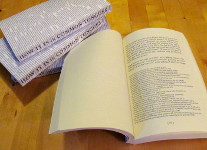
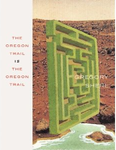

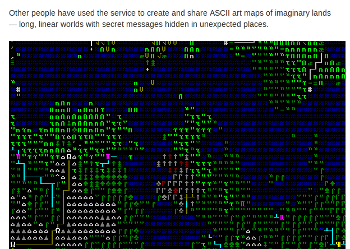
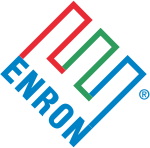
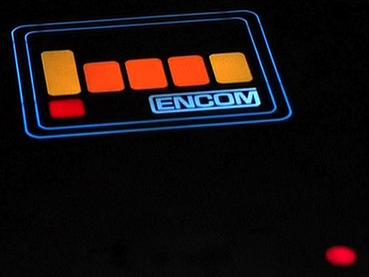
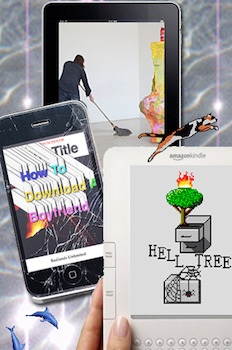

Nema komentara:
Objavi komentar